Aviation in Early Los Angeles
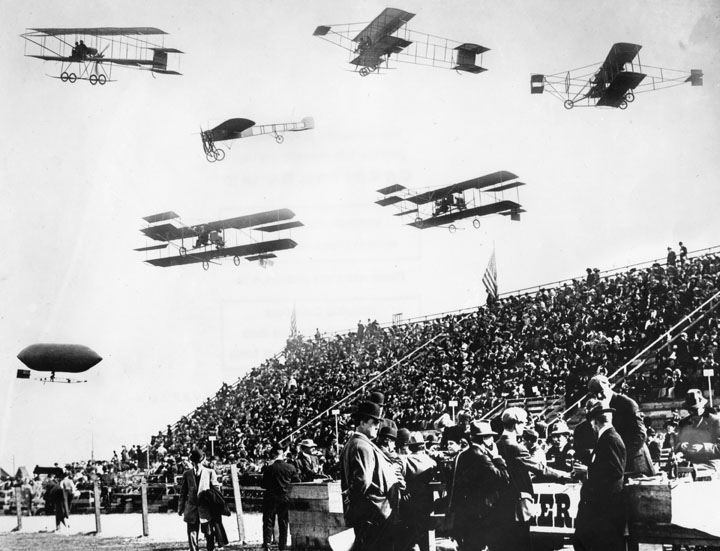 |
|
| (1910)* - Composite photograph of early-model biplanes, a monoplane, and a dirigible passing by bleachers filled with spectators at the 1910 Dominguez Field Air Meet. |
Historical Notes The Los Angeles International Air Meet (January 10 to January 20, 1910) was among the earliest airshows in the world and the first major airshow in the United States. It was held in Los Angeles County, California at Dominguez Field in present day Carson, California. Spectator turnout numbered approximately 254,000 over 11 days of ticket sales. The Los Angeles Times called it "one of the greatest public events in the history of the West”.*^ |
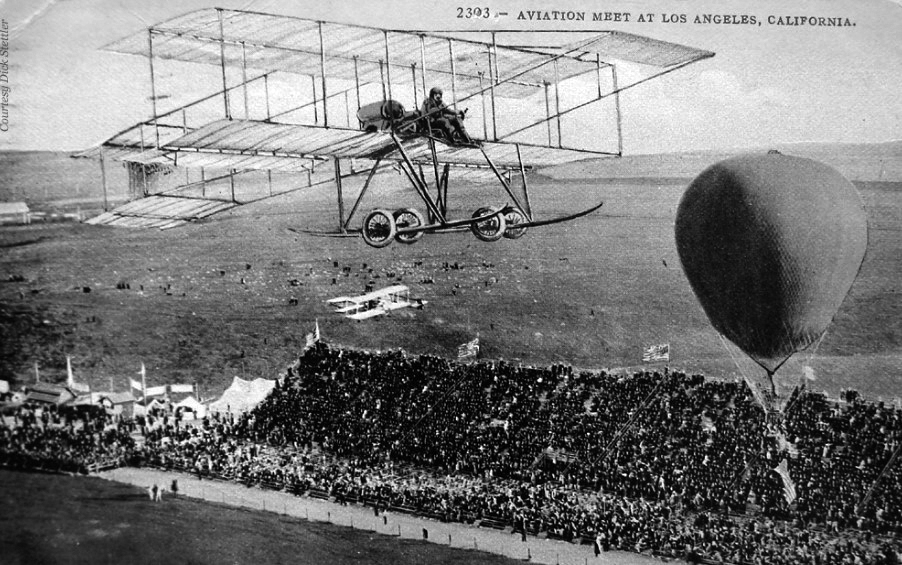 |
|
| (1910)*##^ – Postcard view of the Los Angeles International Air Meet in Dominguez Hills. |
Historical Notes Following the Reims International Air Meet of 1909 (France) enthusiasm for aviation began to increase in the United States. At an aviation meet in St. Louis fellow enthusiasts discussed the possibility of holding an air meet in Los Angeles. This group, which included Charles Willard, Roy Knabenshue, and Glenn Curtiss, followed through on the proposed project and sent Dick Ferris to Los Angeles to make the preliminary contacts and finalize the plans for the proposed Air Meet. After arriving in Los Angeles Ferris met with various contacts and an International Air Meet was proposed which would include Louis Paulhan-a renowned French aviator. The location was selected, Dominguez Field, which was part of one of the original Spanish land grants-The Rancho San Pedro. - Peter Bergen^* This site, Dominguez Hill Field, has been designated California Historical Landmark No. 718. Click HERE to see more of California Historical Landmarks in LA. |
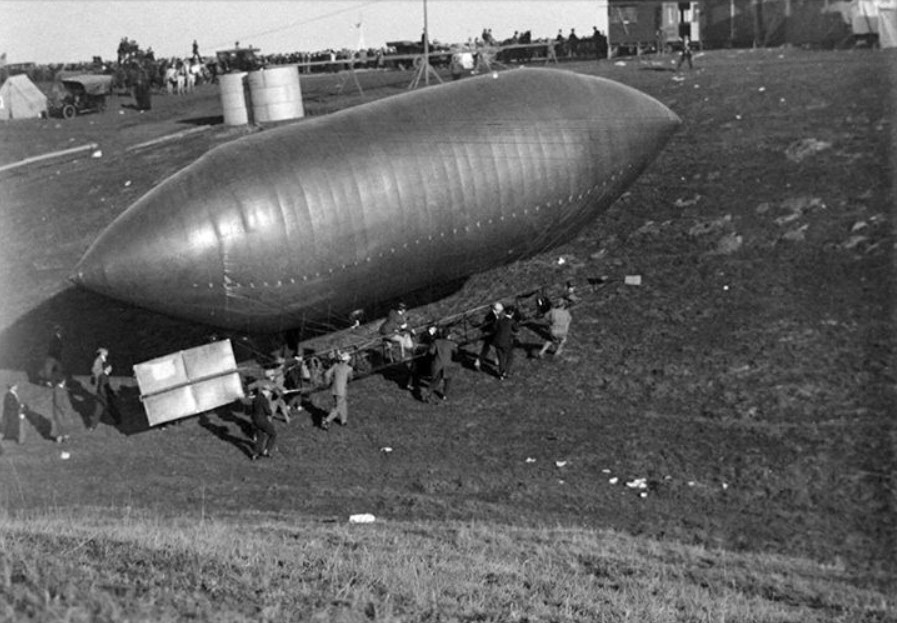 |
|
| (1910)*** - A crew moving a dirigible at the Los Angeles International Air Meet at Dominguez Field. |
Historical Notes A dirigible (or airship) is a type of aerostat or "lighter-than-air aircraft" that can be steered and propelled through the air using rudders and propellers or other thrust mechanisms. Unlike aerodynamic aircraft such as fixed-wing aircraft and helicopters, which produce lift by moving a wing through the air, aerostatic aircraft stay aloft by having a large "envelope" filled with a gas which is less dense than the surrounding atmosphere.*^ |
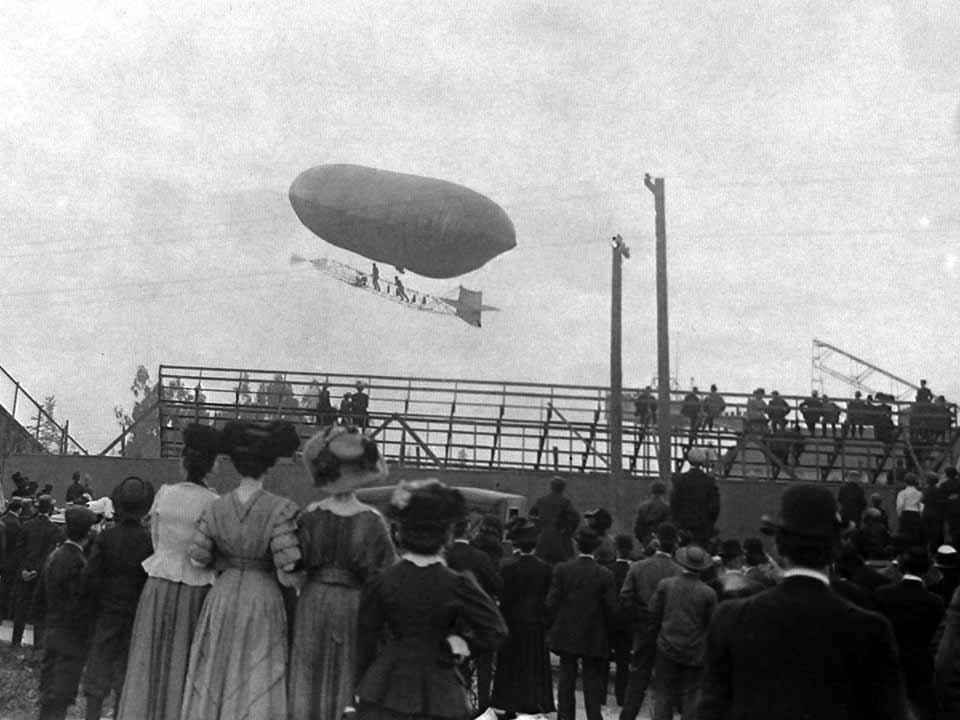 |
|
| (1910)^*^# – Spectators watch as a two-man dirigible flies over the stands at the International Air Meet. |
Historical Notes The first lifting gas used by dirigibles was hydrogen, although this had well-known concerns over its flammability. Helium was rare in most parts of the world, but large amounts were discovered in the USA. This meant that this non-flammable gas was rarely used for airships outside of the USA. All modern airships, since the 1960s, use helium.*^ |
 |
|
| (1910)* - Lincoln Beachey is seen flying an airship; the number "2" can be seen on the rudder. |
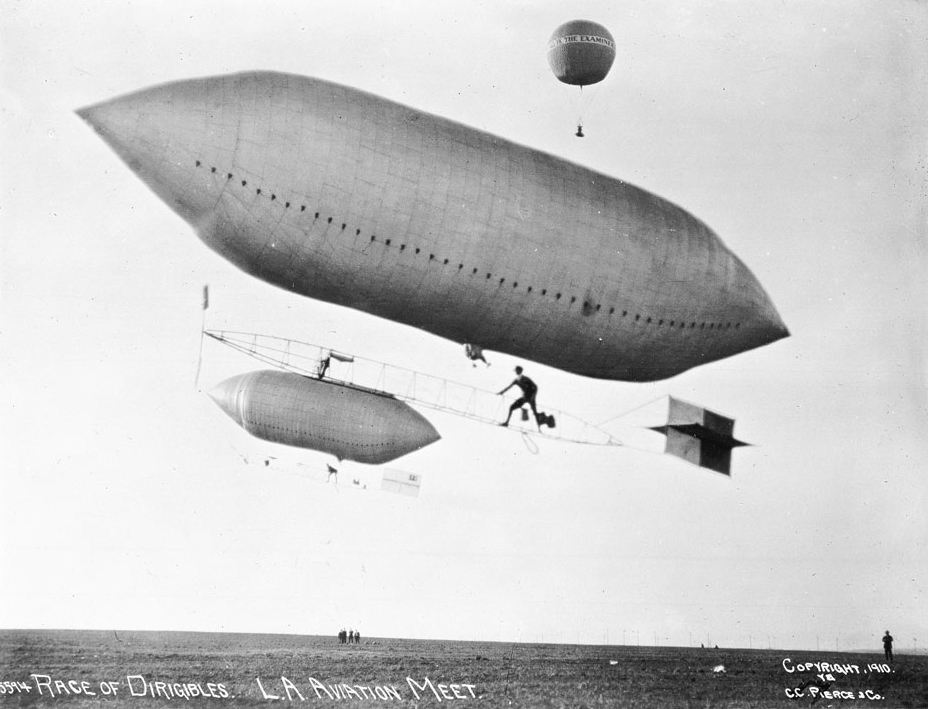 |
|
| (1910)^* - Photograph of dirigible race in the Dominguez Air Meet, Dominguez Field, Los Angeles, 1910. Two football-shaped zeppelins race across the skies, flying at low altitude. Each of them has single pilots. The pilots stand on a skeletal structure consisting of metal bars that is attached to the balloon with wires. Spectators (or judges) stand below on the plain field watching the zeppelins race. Further in the sky is a balloon with the phrase "all in the Examiner." |
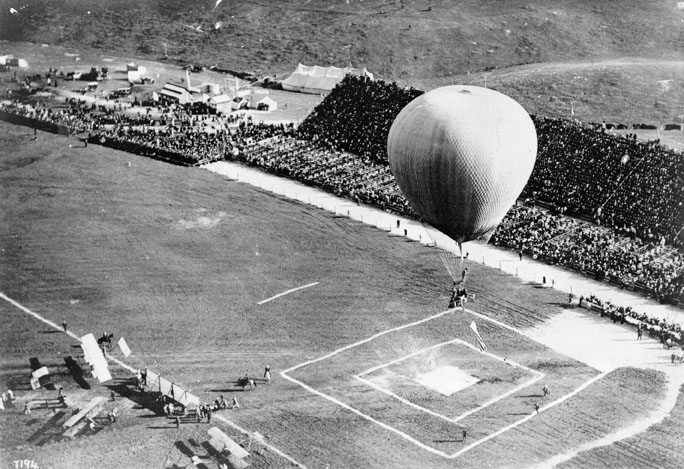 |
|
| (1910)* - Hamm's (otherwise unidentified) balloon in front of the grand stand of the 1st Aviation Meet. On the ground are three concentric rectangles serving as take-off and landing area. |
Historical Notes There were two International Aviation Meets held at Dominguez Field, Los Angeles. The first ran from Jan. 10-20, 1910; the second from Dec. 24-30, 1910-Jan. 1 and 3, 1911.* |
_1910.jpg) |
|
| (1910)^*^# – Close-up view of a gas-filled balloon in flight at the Los Angeles International Air Meet at Dominguez Field. |
Historical Notes Between the mid-1860s to 1960s – Gas balloons dominated the hot-air balloon until a modern burner was developed to heat air.*^ |
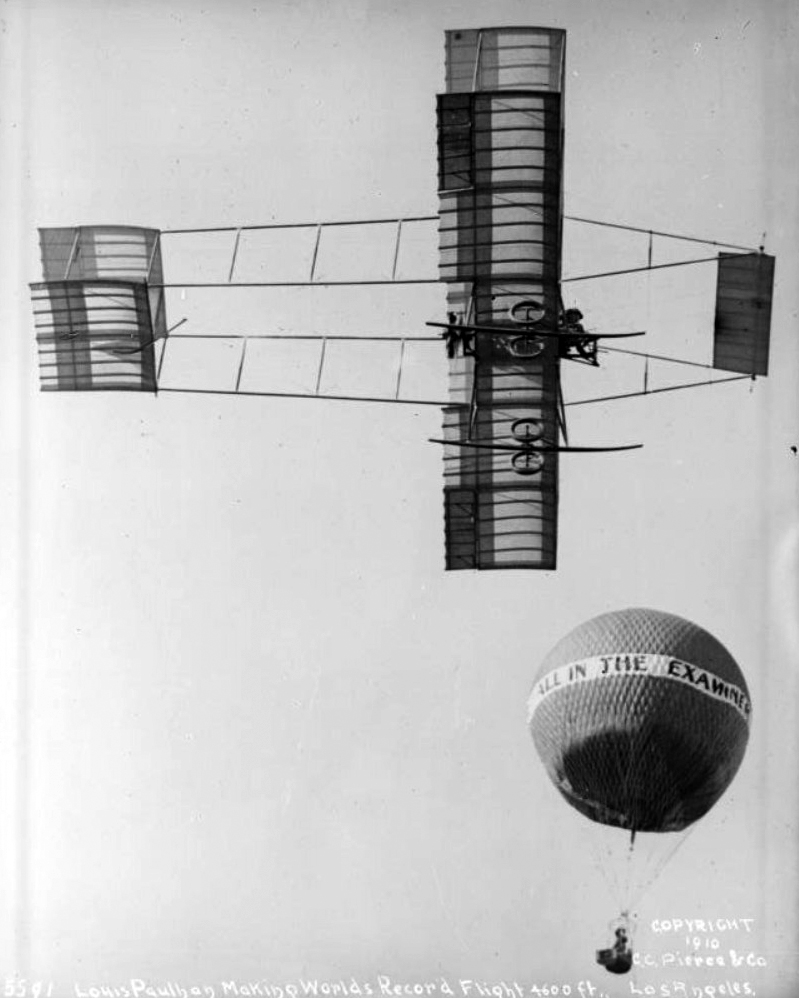 |
|
| (1910)^* - Photograph of Louis Paulhan flying near a gas-filled balloon in his Henry Farman biplane, during his record-breaking flight (4600 ft.) at Dominguez Field, January 12, 1910. Paulhan is sitting at the center of the front wings in this primitive biplane. His biplane passes a nearby balloon with one person piloting it. The advertisement painted on the balloon reads: "All in the Examiner". |
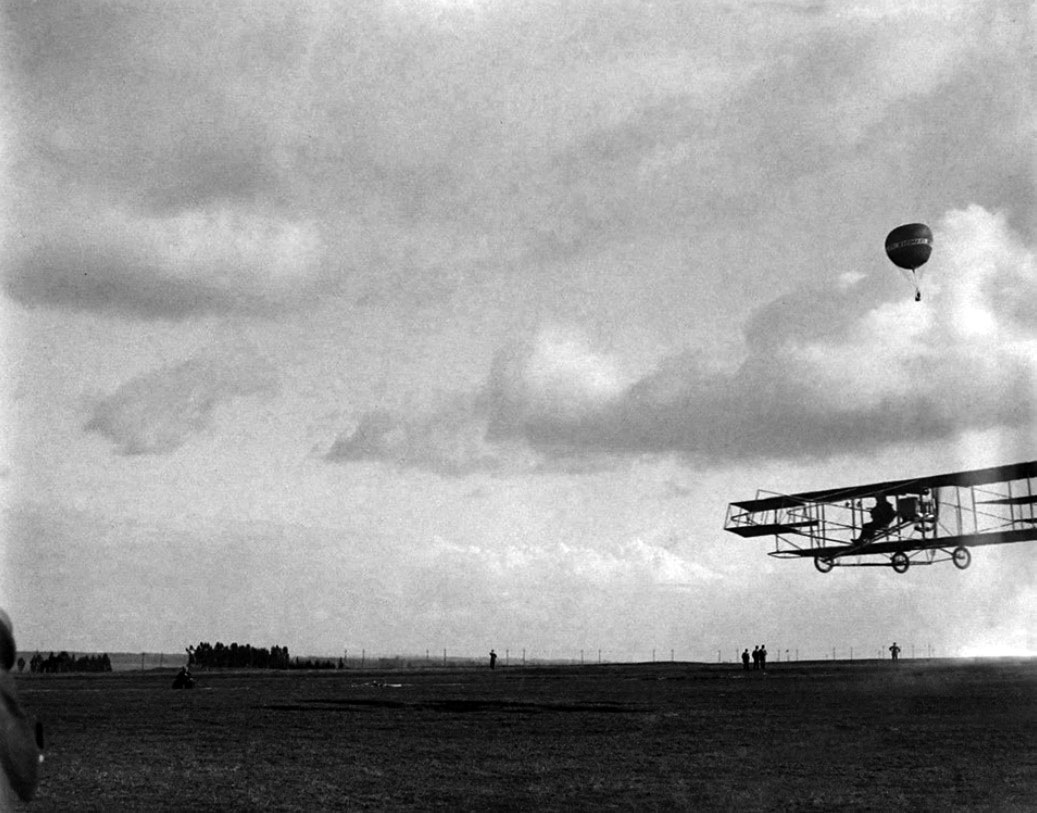 |
|
| (1910)^*^# - View showing a bi-plane flying close to the ground while a balloon at a higher elevation is seen in the distance. |
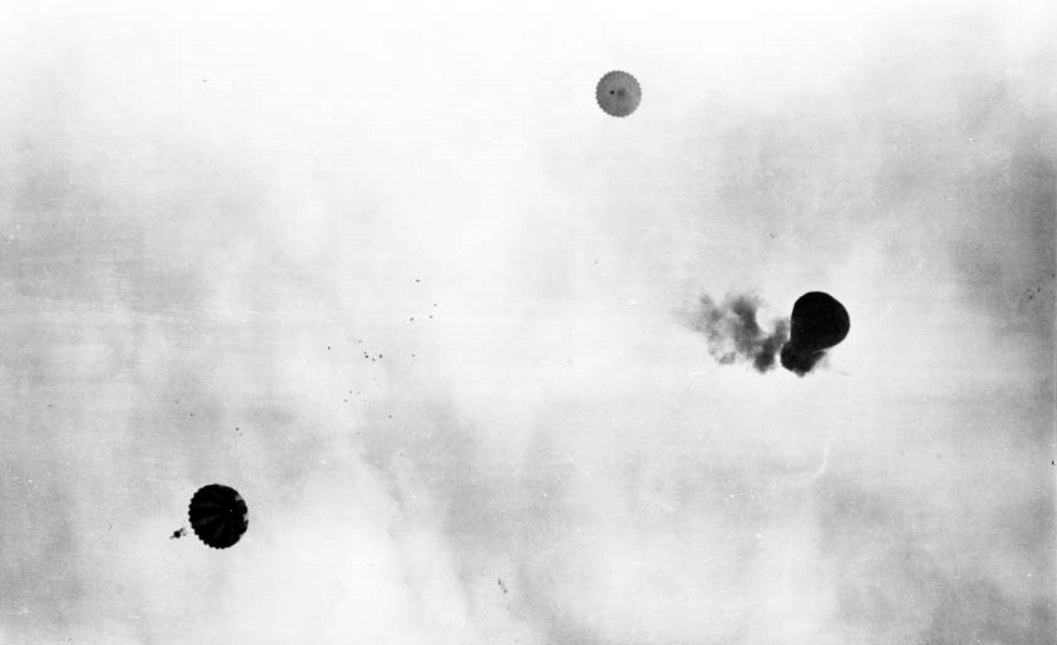 |
|
| (1910)^* - Photograph of two parachutists dropping from a balloon at the Dominguez Hills Air Meet. The balloon appears to be on fire with smoke coming from its basket. |
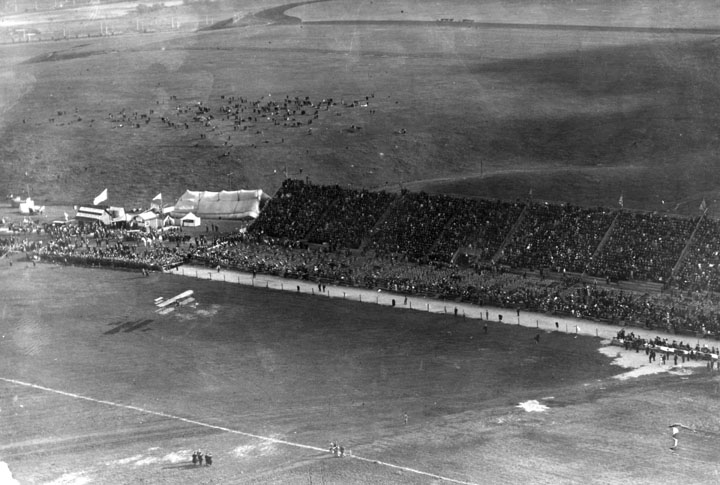 |
|
| (1910)* - Thousands watch a biplane in low flight over Dominguez Field. |
Historical Notes An estimated 254,000 tickets were sold, and gate receipts were roughly $137,500. During the time the meet was running, streetcars ran to Dominguez Fields every 2 minutes from the Pacific Electric station in Los Angeles. The great crowd turn-out, averaging more than 20,000 spectators per day, made it possible to return $1.25 to "the subscribers to the aviation fund for every dollar advanced". Probably not the only future-notable person to see the show, 9-year-old Florence Leontine Lowe, later better known as "Pancho" Barnes, was brought by her grandfather, aviation pioneer Thaddeus S. C. Lowe. It was here that she was inspired to begin her own later career in aviation.*^ |
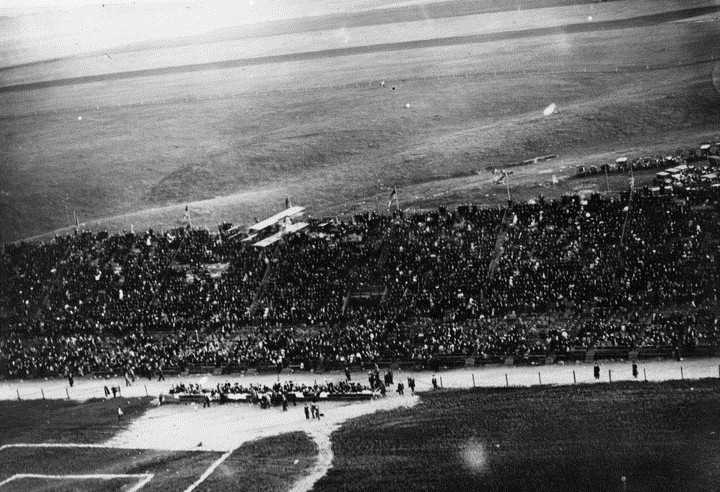 |
|
| (1910)* - Aerial view of Dominguez Field with biplane flying low over a large crowd of spectators. Note the extent of open space in the background behind the stands. |
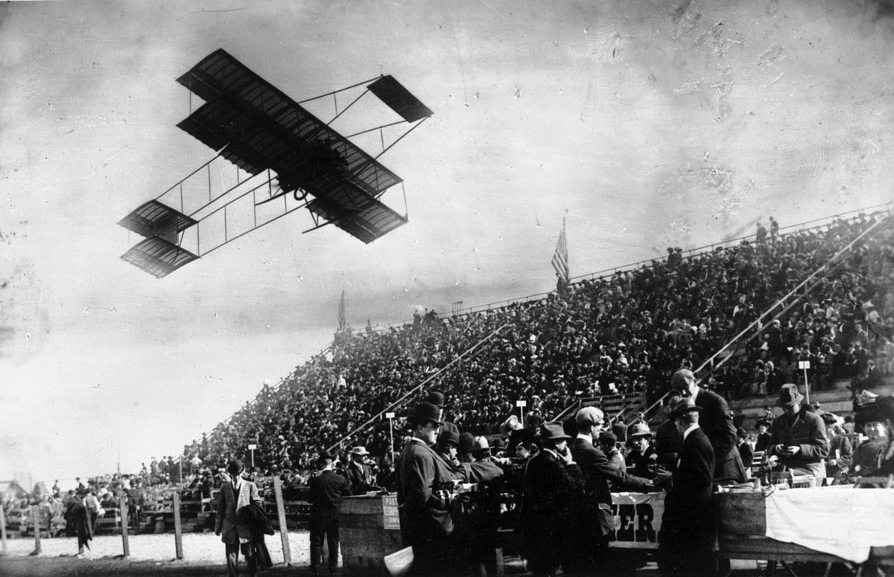 |
|
| (1910)^* - Photograph of aviator Louis Paulhan making his record flight at the Dominguez Hills Air Meet, 1910. Paulhan's Farman airplane is climbing at low altitude at left. It is a biplane with a biplanar tail and a canard fore plane. There is no real fuselage, and the aircraft is held together with wooden beams. A large crowd is gathered and is seated in bleachers at right. There is an American flag hanging at the top of the grandstands. A small group of people is standing around at table in the foreground at right. |
Historical Notes Over the ten-day period of the air meet spectators were thrilled by the performances of aviators Louis Paulhan, Glenn Curtiss, Charles Willard, and others. Paulhan was the 'star attraction' at the air meet. Invited by the organizers to participate, Paulhan brought with him to the event two Bleriot Monoplanes, Two Farman Biplanes, and an entourage, which included his wife and black poodle dog.^* |
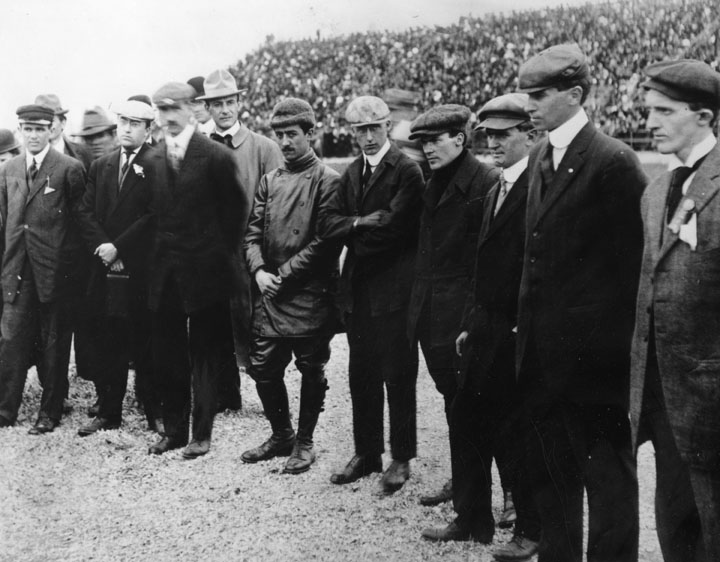 |
|
| (1910)* - Nine famous aviators at Dominguez Field. From left to right: 1. Hilary Beachey; 2. Col. Johnson (FH or FR); 3. Glenn H. Curtiss; 4. Louis Paulhan; 5. Charles F. Willard; 6. Didier Masson; 7. Lincoln Beachey; 8. Roy Knabenshue; 9. Charles K. Hamilton. |
Historical Notes The 1910 Air Meet drew many famous aviators, most of whom were American. Glenn Curtiss, American aviation pioneer and founder of the Curtiss Aeroplane and Motor Company was the most famous. Other participants included Roy Knabenshue, Charles Willard, Lincoln Beachey and Charles K. Hamilton, Howard Warfield Gill, and Clifford B. Harmon, many of whom are listed among the Early Birds of Aviation. French aviators at the event included Louis Paulhan and Didier Masson. The Wright brothers did not take part in the event, but were there with their lawyers in an attempt to prevent Paulhan and Curtiss from flying. The Wrights claimed that the ailerons on their aircraft infringed patents. Notwithstanding their allegations, Paulhan and Curtiss still made flights. As part of the larger Wright brothers' patent cases, the Wrights actually won monetary damages in U.S. courts for Paulhan's public performances that day.*^ |
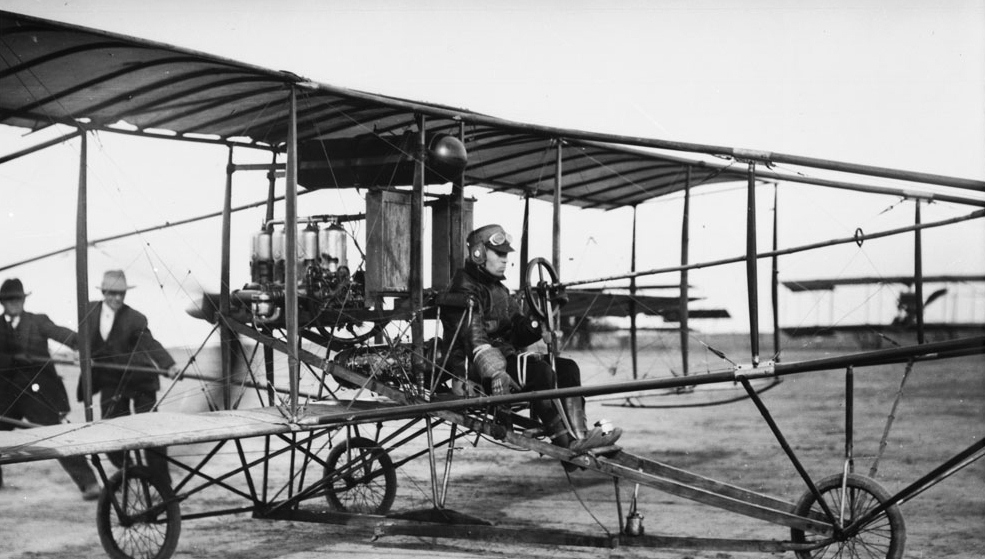 |
|
| (1910)^* - Elmer Cooke at the controls of a Curtiss biplane at the Dominguez Hills Air Meet. Cooke is at center and is facing the right. He is holding a control wheel in front of him and his other hand is reaching for another control. He is wearing a heavy jacket and gloves, as well as a hat with ear covers and goggles. His plane is a biplane with canvas-covered wings and the engine is mounted directly behind the pilot. There are two men holding a long rod attached to the plane at left, and another biplane is visible in the distance at right. |
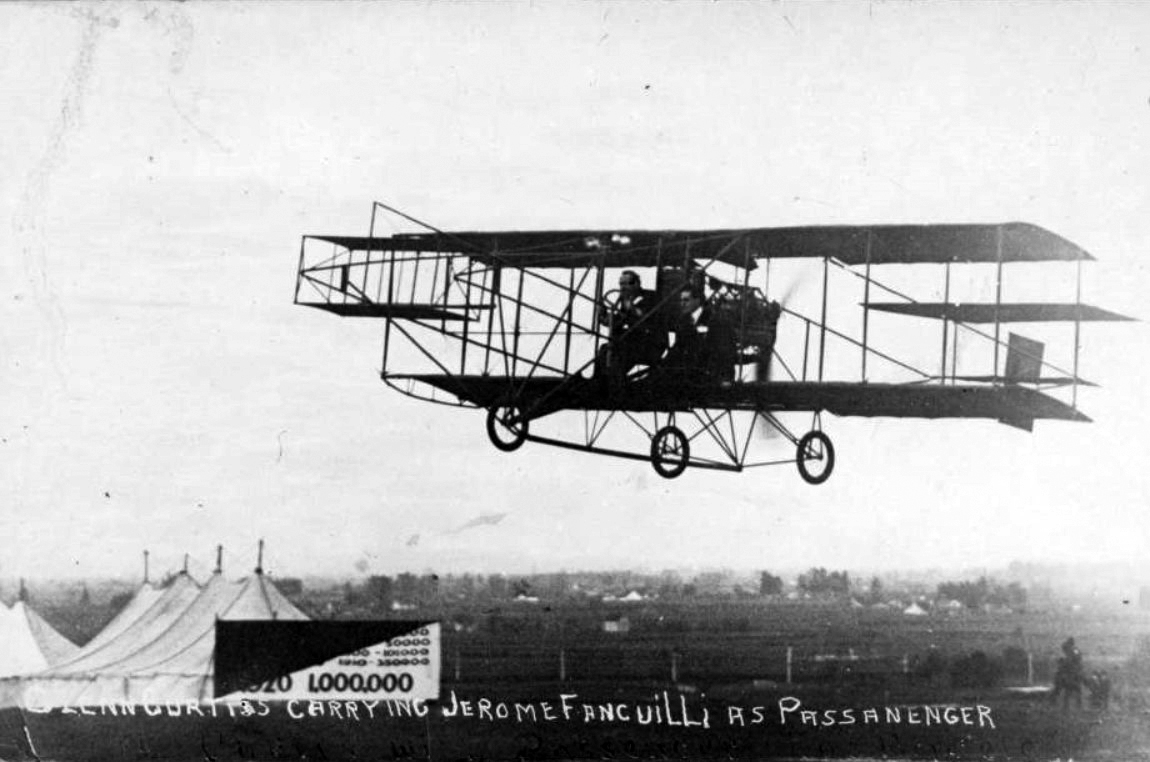 |
|
| (1910)^* - View showing Glenn Curtiss carrying Jerome Fancuilli as passenger at the Dominguez Air Show. At center, Glenn Curtiss is seen gripping a round steering wheel and piloting a simple biplane. To the right, Jerome Fancuilli sits on the frame of the plane as it moves through the air. Below the plane in the foreground, several lightly-colored tents and a banner are visible. |
Historical Notes Glenn Curtiss was an aviation pioneer and a founder of the U.S. aircraft industry. He began his career as a bicycle racer and builder before moving on to motorcycles. As early as 1904, he began to manufacture engines for airships. In 1908 Curtiss joined the Aerial Experiment Association (AEA), a pioneering research group, founded by Alexander Graham Bell at Beinn Bhreagh, Nova Scotia to build flying machines. Curtiss made the first officially witnessed flight in North America, won a race at the world's first international air meet in France, and made the first long-distance flight in the United States. His contributions in designing and building aircraft led to the formation of the Curtiss Aeroplane and Motor Company, now part of Curtiss-Wright Corporation. His company built aircraft for the U.S. Army and Navy, and, during the years leading up to World War I, his experiments with seaplanes led to advances in naval aviation.*^ |
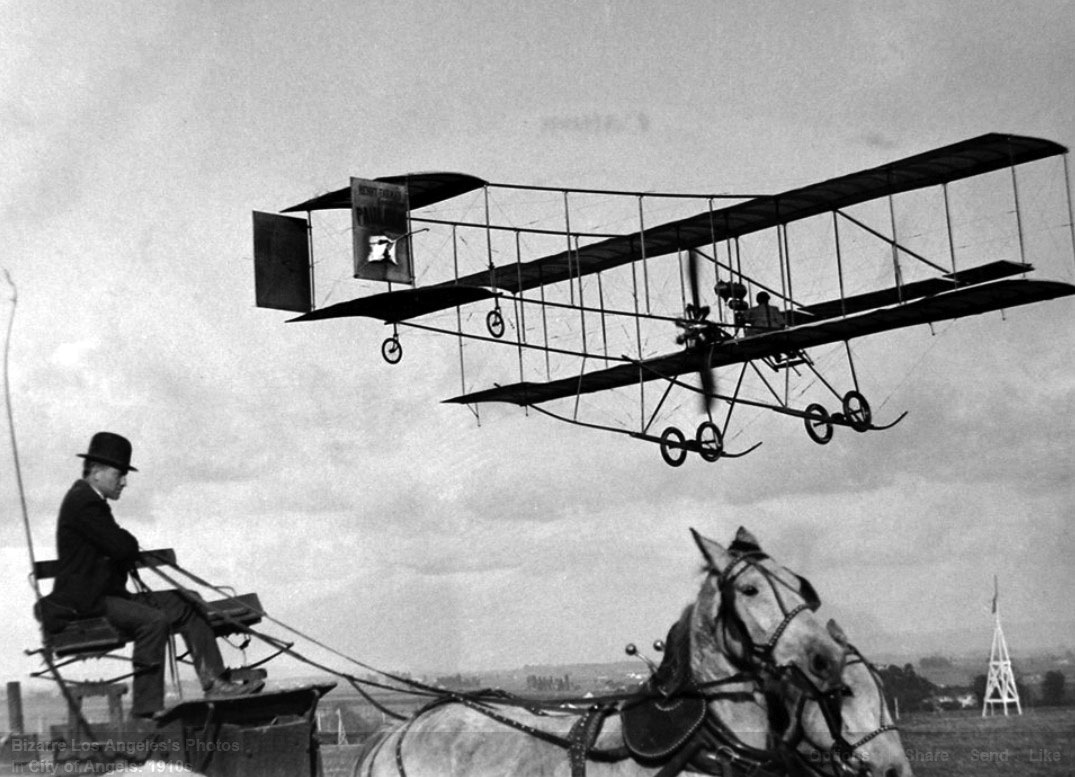 |
|
| (1910)^*^# – French Aviator Louis Paulhan flies over while a man in a horse-drawn wagon watches. |
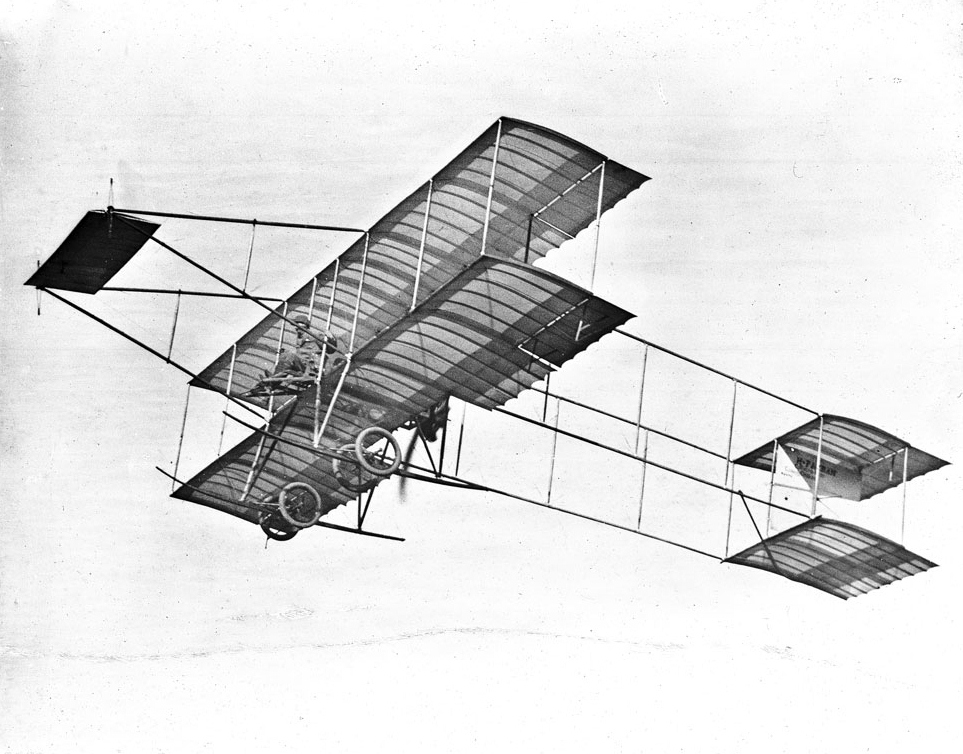 |
|
| (1910)^* - Louis Paulhan making his record flight, flying at 4,600 feet, in his Henry Farman biplane, Dominguez Field, Los Angeles, January 12, 1910. Paulhan is sitting at the center of the front wings in this primitive biplane. He holds onto the nearest supporting bar as he pilots the airplane. The nose is triangular shaped with a wing (or flap) in the center of the nose. A propeller spins just below the wings and between the two pairs of landing wheels. The rear of the plan consists of two square wings with a flap that runs perpendicular to the wings. |
Historical Notes At the air meet Louis Paulhan set a new altitude record (4164 ft.), endurance record (64 miles in 1 hr. 49 mins. 40 secs.), and won $14,000 in prize money. Glenn Curtiss won two events-fastest speeds with a passenger (55 mph) and quickest start (6 2/5 secs. covering 98 ft.). Curtiss took home $6500 in prize money. Charles Willard was credited with the most accurate takeoff and landing skills for which he receive a prize totaling $250.^* |
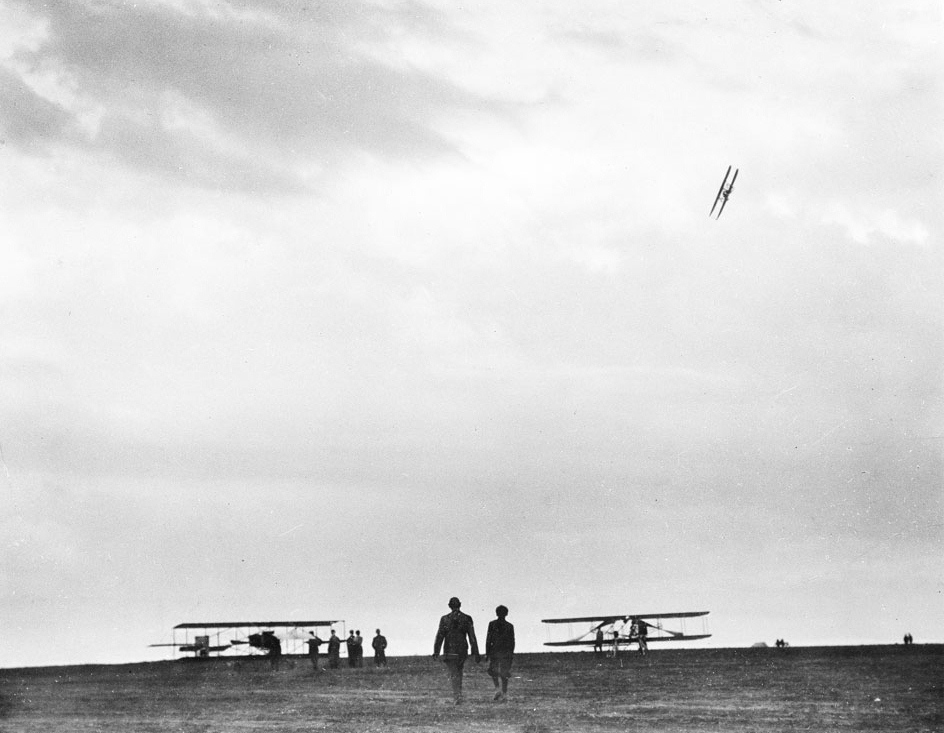 |
|
| (1910)^* - View of the airfield at the Dominguez Hills Airmeet. W.R. Brookins is shown airborne in his Wright Model A biplane, which is visible in the right sky as it executes a turn. Two other biplanes are visible on the ground. A group of five people can be seen standing around the plane on the left, while a lone pilot stands near the plane on the right. In the foreground at the center of the picture, two people are walking towards the grounded planes. On the horizon, two more small groups of people can be seen. |
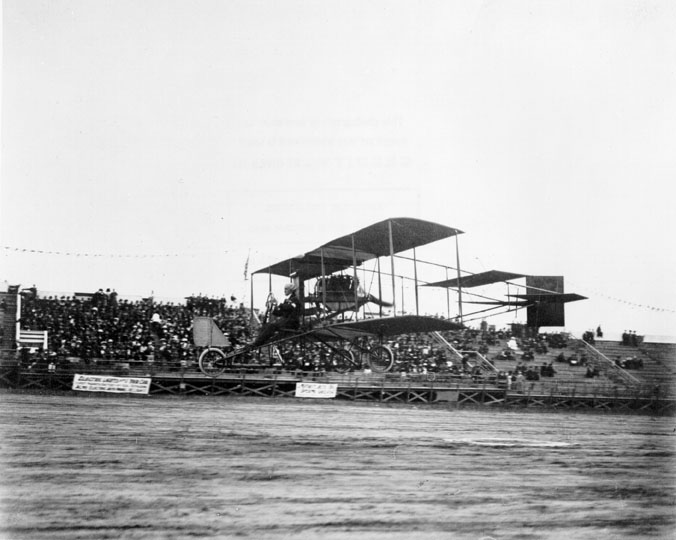 |
|
| (1910)* - Lincoln Beachy landing a biplane on Dominguez Field. |
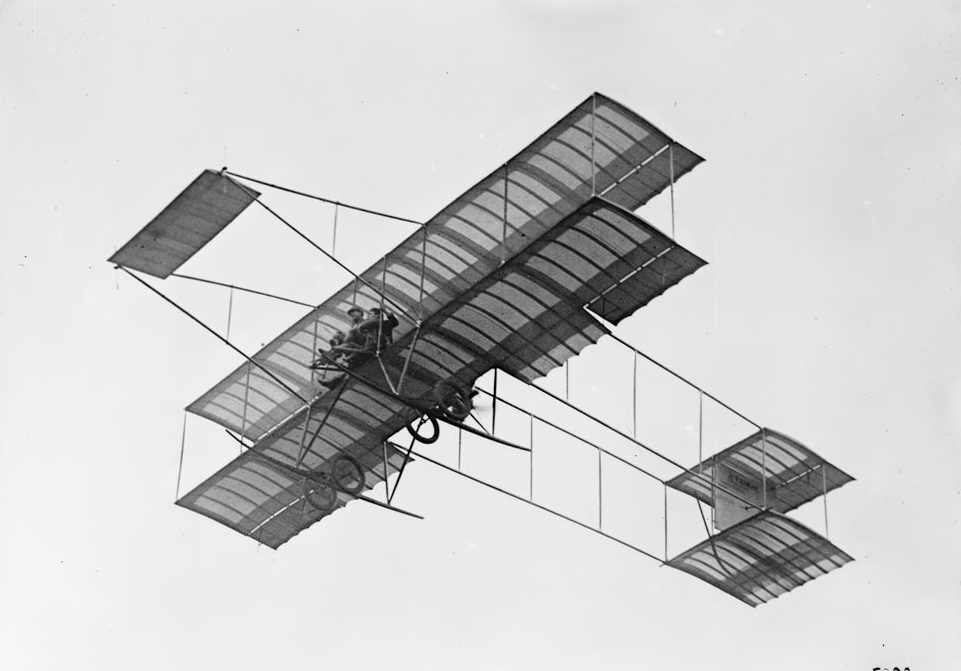 |
|
| (1910)^* - Louis Paulhan flying with a passenger (Mrs. Dick Ferris?) in his Henry Farman biplane, at the Dominguez Field Air Meet, Los Angeles, January 1910. |
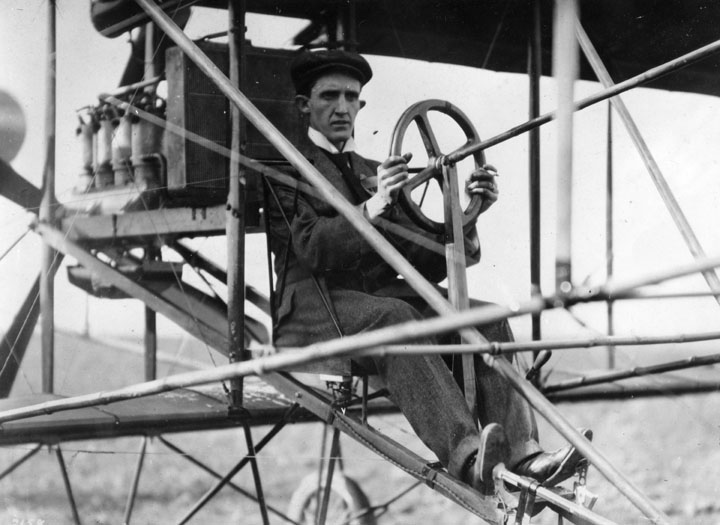 |
|
| (1910)* - Charles K. Hamilton at the controls of a plane on the ground. |
 |
|
| (1910)* - Biplane in flight low above the ground, possibly during take-off. |
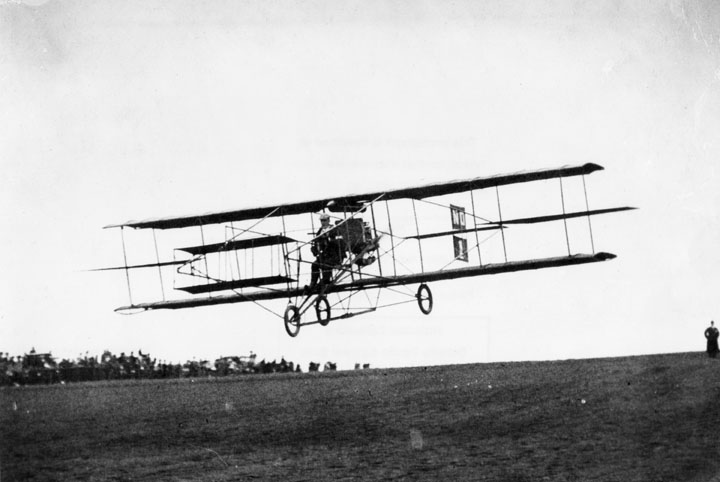 |
|
| (1910)* - Charles F. Willard in a Curtiss aircraft "Golden Flyer" during landing at the 1st Meet, January, 1910. Aircraft had 4 cylinders, 22-25 hp and a speed of 40 mph. |
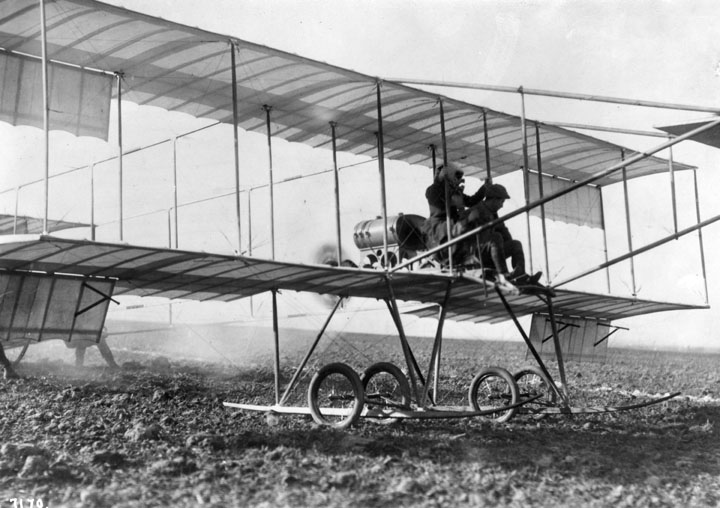 |
|
| (1910)* - Louis Paulhan and his wife are shown during take-off in their Farman biplane during the 1st Meet in January, 1910. |
Historical Notes Paulhan gave William Randolph Hearst his first experience of flight. However, William Boeing, who had been enthused by the new invention of the airplane, was unable to get a ride on any aircraft at the air meet. While attending the first American Air Meet in Los Angeles, Boeing asked nearly every aviator for a ride, but no one said yes except Louis Paulhan. For three days Boeing waited, but on the 4th day he discovered Paulhan had already left the meet. Possibly, one of the biggest missed opportunities in Paulhan's life was the ride he never gave Boeing.*^ |
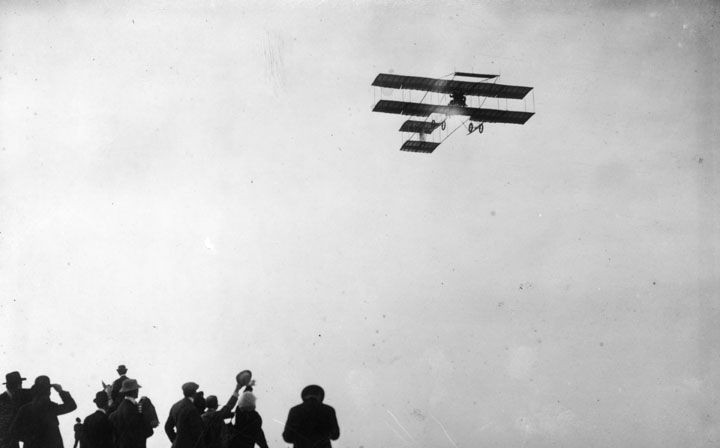 |
|
| (1910)* - Louis Paulhan and his wife are shown in flight in their Farman biplane. |
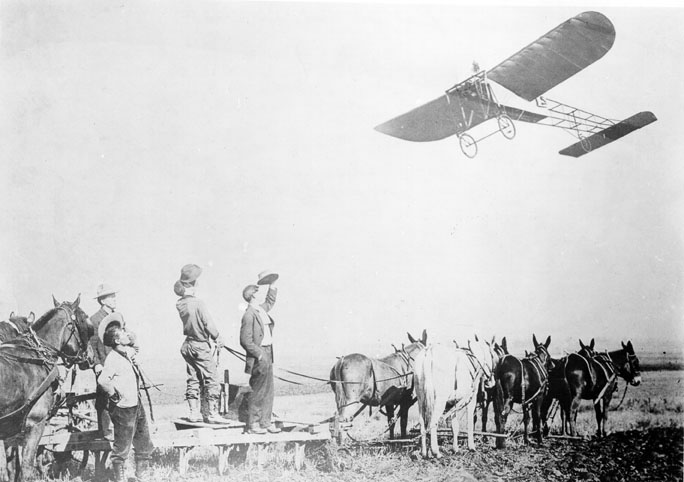 |
|
| (1910)* - Spectators watch as Louis Paulhan flies a Bleriot monoplane at the nation's first Air Meet. |
Historical Notes Gaining attention as the aeroplane used in the first crossing of the English Channel, in 1909, the Bleriot Monoplane became one of the earliest single wing designs to be favored by early aviators. Two of the monoplanes were brought across the Atlantic to the 1910 Air Meet by pilot Louis Paulhan and performed admirably at the event.^##* |
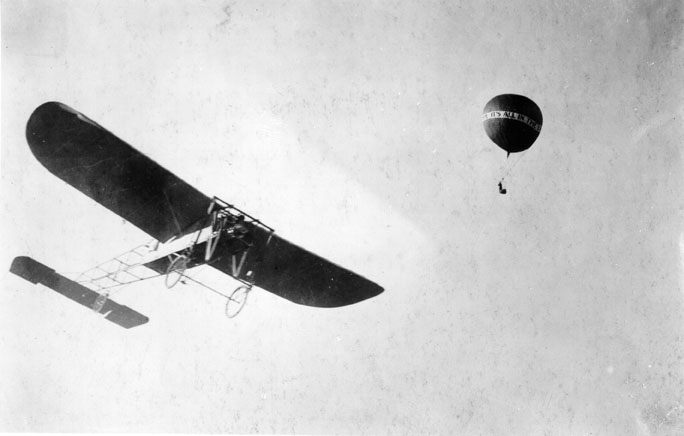 |
|
| (1910)* - A monoplane and a balloon are seen against the sky. |
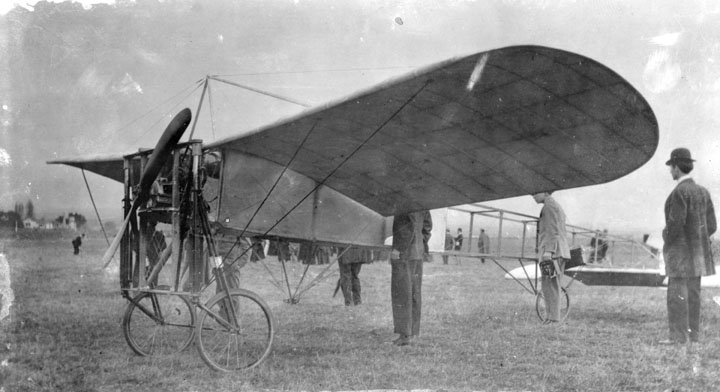 |
|
| (1910)* - Side view of a monoplane. Men are gathered around, gazing at the plane, including one holding a camera. |
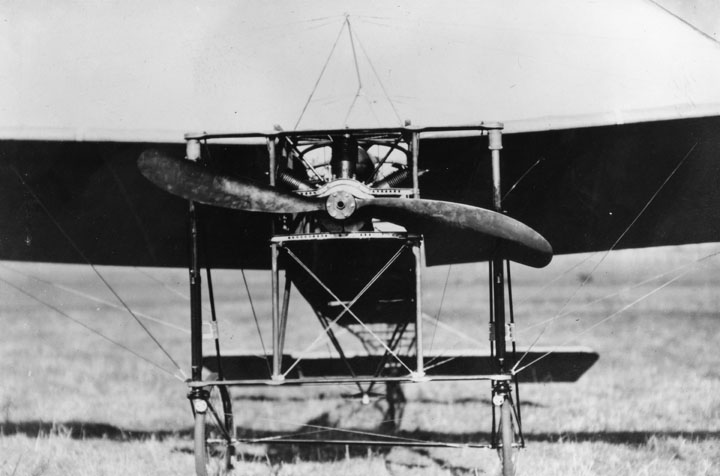 |
|
| (1910)* - A close-up of the propellor and front end of a French monoplane on the Dominguez Airfield. |
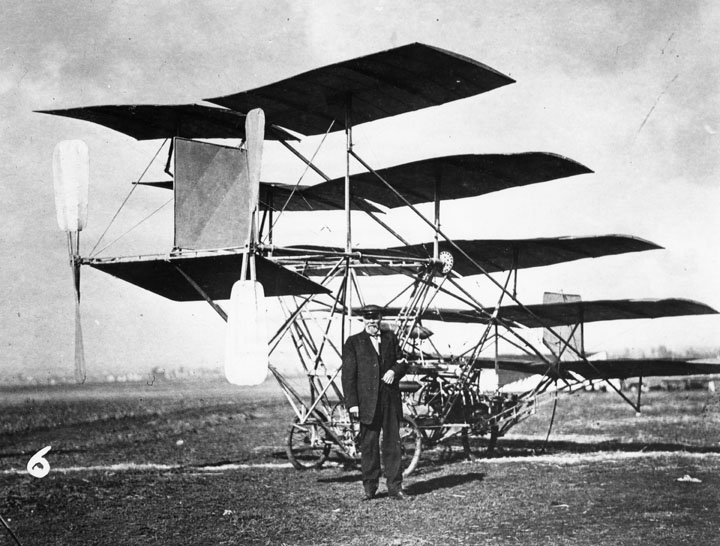 |
|
| (1910)* - Professor J.S. Zerbe stands in front of his multiplane, an 8 cylinder, aircooled airplane, with 5 planes and 2 props. |
Historical Notes One of the more unusual planes seen at the Dominguez Air Show was Los Angeles resident Jerome Slough Zerbe's so-called "Multi-plane," a construction which boasted five separate "planes" of wings attached to an elaborate chassis. Unfortunately for Zerbe, his creation hit a hole in the field and collapsed during take-off, ruining several of the wings and making filght impossible.*^ |
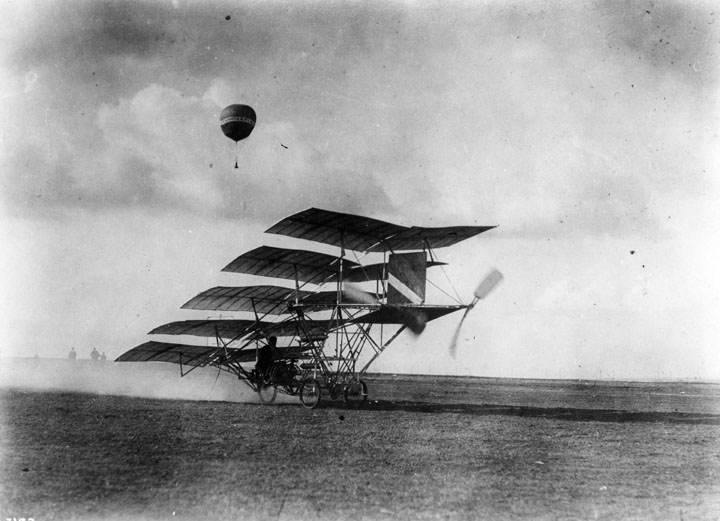 |
|
| (1910)* - Professor Zerbe's multiplane is attempting to take-off on Dominguez Field, with a gas-filled balloon in flight in the background. |
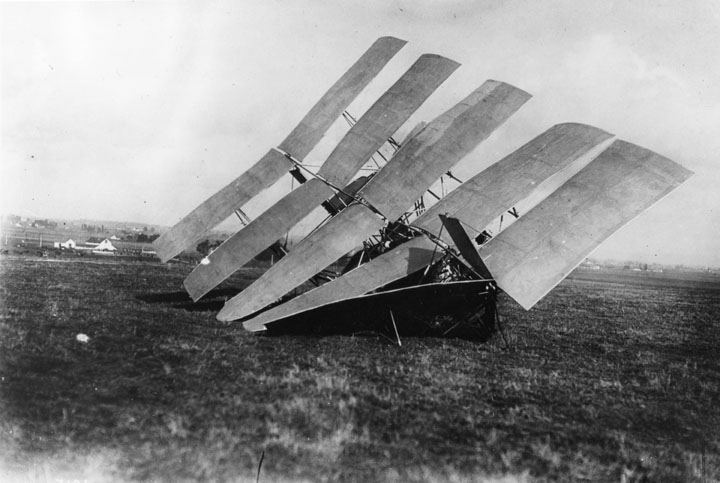 |
|
| (1910)* - This photograph depicts the aftermath of Zerbe's multiplane crash just after it hit a hole on the runway during its take-off attempt. |
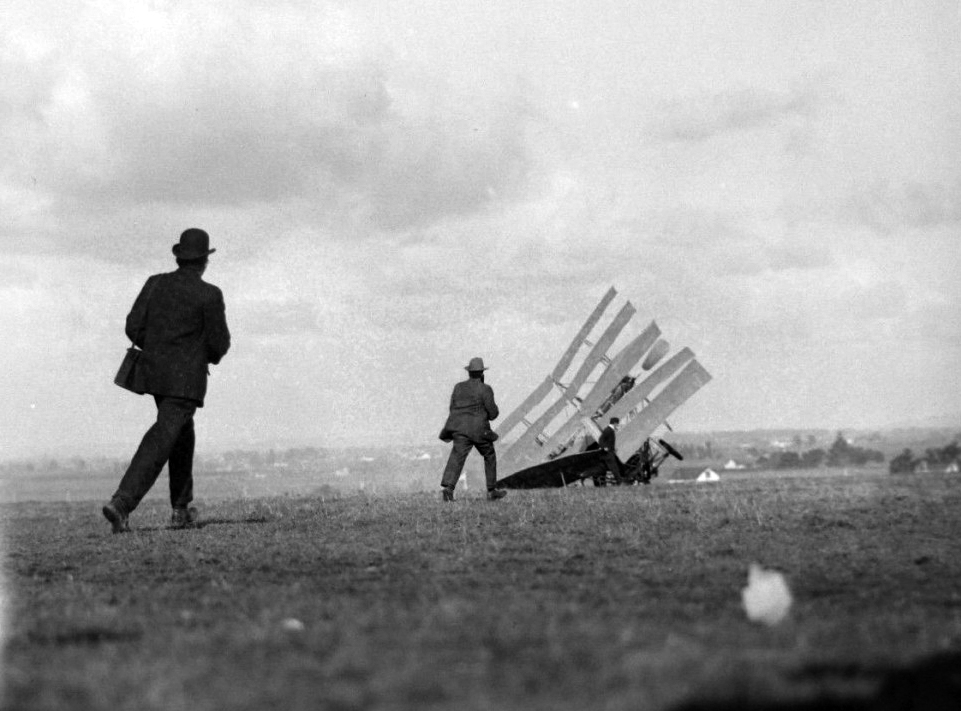 |
|
| (1910)^*# - View showing two men running toward the “multiplane” after its crash. |
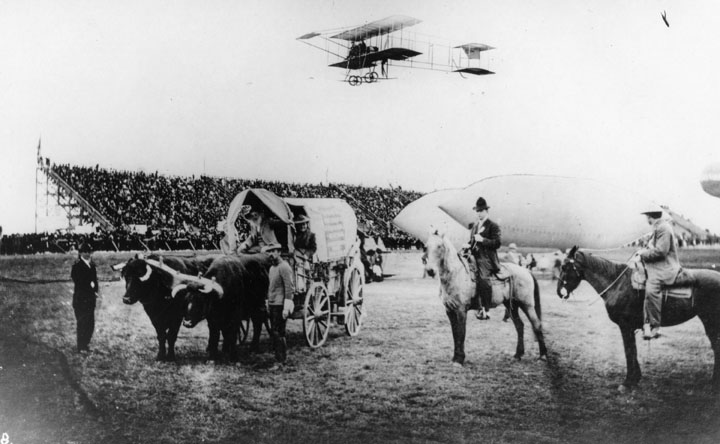 |
|
| (1910)* - Five different modes of transportation are shown: airplane, balloon, blimp, horseback riding and a team of oxen pulling a wagon. All this in front of a large audience at the first U.S. International Air Meet. |
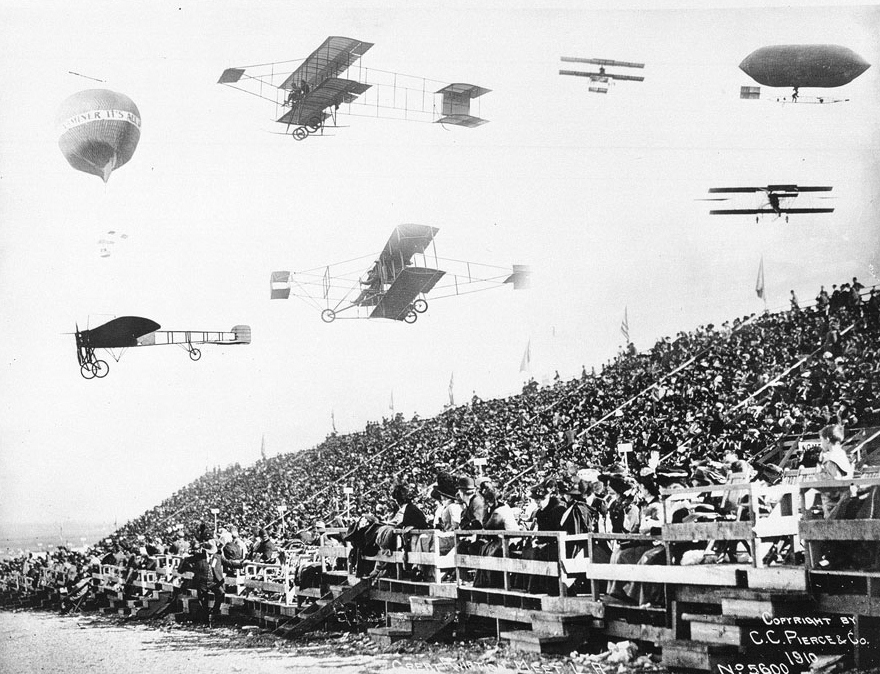 |
|
| (1910)^* - Another composite photograph of early-model biplanes, a monoplane, a gas-filled balloon, and a dirigible (also gas-filled) hovering above or flying by bleachers filled with spectators at the 1910 Dominguez Field Air Meet, January 1910. Most of the spectators have their head turned to the right, including people who are seated beyond the planes that are passing overhead. "All in the Examiner" is an advertisement that is painted on the balloon (at left). Flags are placed at intervals at the top of the bleachers. Caption reads: "Great Aviation Meet, L.A.". |
Historical Notes Attendance at the air meet reached and surpassed all expectations. During the ten-day period of the air meet an estimated 226,000 spectators converged on Dominguez Field. Gate receipts for the event equaled over $137,500. The air meet was considered a phenomenal success and helped to alleviate a perceived economic drought in the Los Angeles area.^* |
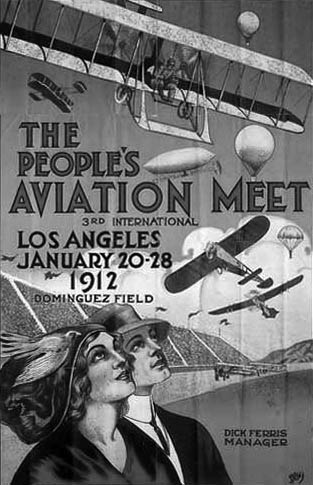 |
(1912)+^^ - Poster for the 3rd International People's Aviation Meet at Dominguez Field.
|
Historical Notes The 1912 Los Angeles International Aviation Meet was held on Dominguez Mesa, and was known as "The People's Aviation Meet." It was the third aviation meet held in Los Angeles, California. Lincoln Beachey was one of the star aviators at the meet which also featured Charles Willard, Blanche Stuart Scott, Phil Parmelee, Cliff Turpin, Glenn Martin, Howard Gill, and Farnum Fish, among others. |
Women in Aviation
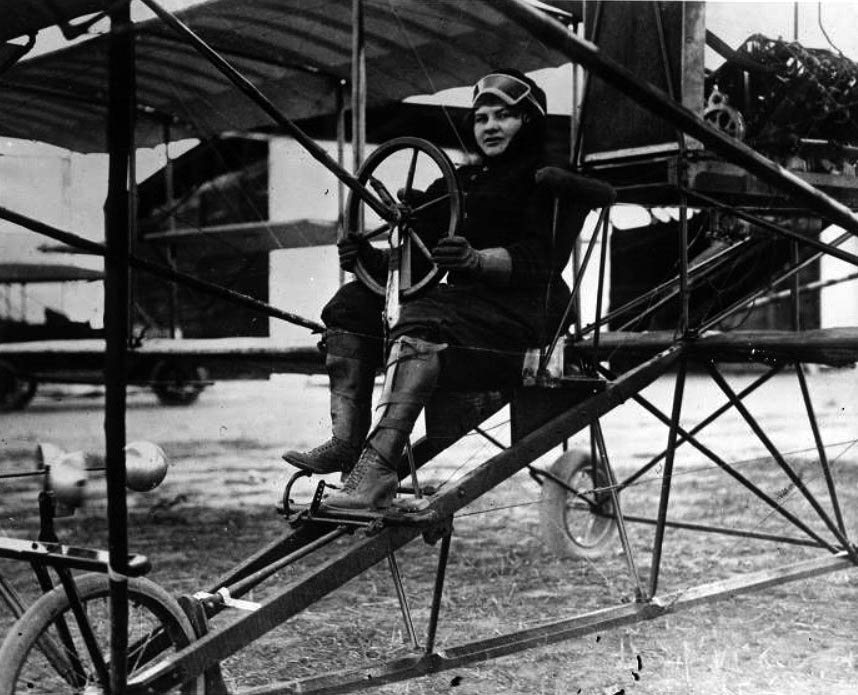 |
|
| (ca. 1912)#* - Blanche Scott, first American woman to fly, Dominguez Field. |
Historical Notes Blanche Stuart Scott (April 8, 1885 – January 12, 1970) is credited by the Early Birds of Aviation as the first woman to pilot and solo in an airplane in the U.S. (1910). She then went on to become a professional pilot, making her debut on October 24, 1910, as a member of the Curtiss exhibition flying team at an air meet in Fort Wayne, Indiana. This made her the first woman to fly at a public event in America.+^# |
.jpg) |
(ca. 1912)+^# - Blanch Scott ready to fly in her stylish outfit. Wow!
|
Historical Notes In 1911 Scott became the first woman in the U.S. to fly long distance when she flew 60 miles (non-stop from Mineola, New York. In 1912 she contracted to fly for Glenn Martin+ and became the first female test pilot when she flew Martin prototypes before the final blueprints for the aircraft had been made.+^# + Glenn Martin was an airplane designer, founding his own company which later evolved into Lockheed Martin). |
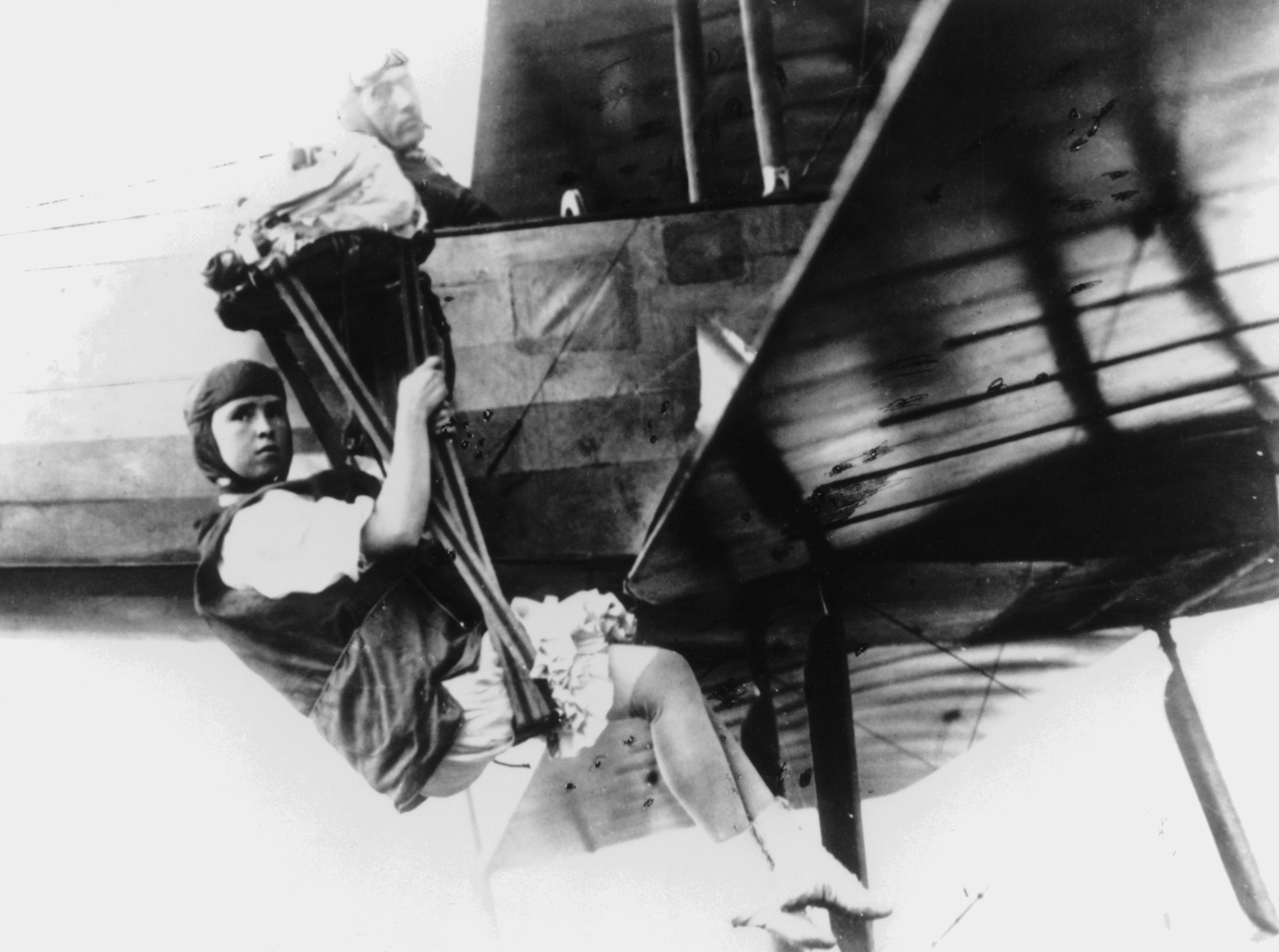 |
|
| (ca. 1913)+# - View showing 'Tiny' Broadwick as she prepares to parachute out of a plane. |
Historical Notes Georgia Ann Thompson Broadwick was an American pioneering parachutist. She was nicknamed 'Tiny', as she weighed only 85 pounds and was 5 feet tall. At the age of 15 she saw Charles Broadwick's World Famous Aeronauts parachute from a hot air balloon and decided to join the travelling troupe. She later became Broadwick's adopted daughter. Although she would eventually make her jumps from an airplane, in her earlier career she was jumping from balloons. Billed as "the doll girl," Tiny began performing aerial skydives and stunts while wearing a "life preserver" designed by her adopted father. On December 28, 1908, Tiny made her very first jump out of a hot air balloon. The skydiving family traveled around and performed at fairs, carnivals, and parks. Among her many other achievements, she was the first woman to parachute from an airplane, which she accomplished on June 21, 1913, over Los Angeles, with aviator Glenn L. Martin as the pilot. These early jumps included a well-publicized jump on January 9, 1914, from a plane built and piloted by Martin, 1,000 feet over Griffith Park in Los Angeles, California. She was also the first woman to parachute into water.*^ |
Santa Monica
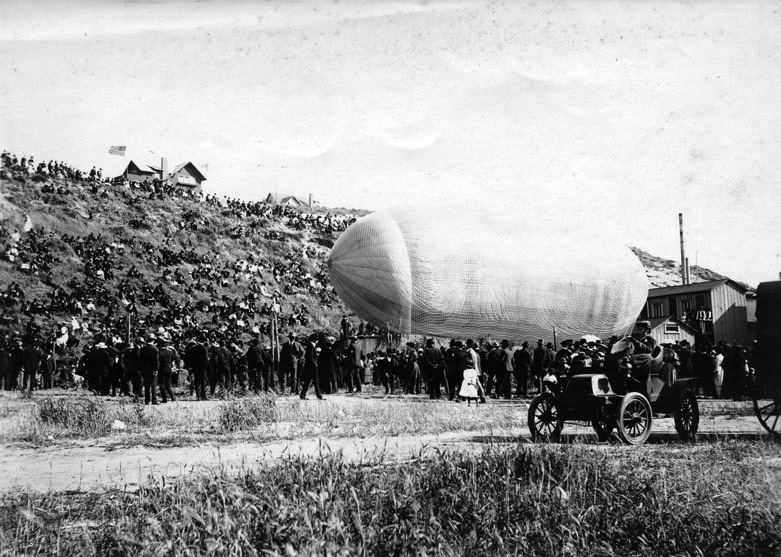 |
|
| (1905)^**^ – View showing Thomas Baldwin’s dirigible in Santa Monica surrounded by a large number of spectators. The hillside is also covered with people waiting to see the airship’s flight. |
Historical Notes Thomas Scott Baldwin was a pioneer balloonist and U.S. Army major during World War I. He was the first American to descend from a balloon by parachute. In 1900, Baldwin created a motorized balloon. He used a motorcycle engine built by Glenn Hammond Curtiss and an aerodynamic cigar-shaped, hydrogen filled, balloon. He created the dirigible "California Arrow", which underwent the first controlled circular flight in America on August 3, 1904. The aircraft was piloted by Roy Knabenshue at the 1904 Louisiana Purchase Exposition in St. Louis. The Army Signal Corps paid him $10,000 for a dirigible that could be used for sustained and controlled navigation. Baldwin created a dirigible that was 95 feet long and powered by a new, more powerful Curtiss engine. The Army bought it and designated its first dirigible "SC-I" (Signal Corps Dirigible Number 1). Baldwin picked up the sobriquet: "Father of the American Dirigible." He received the Aero Club of America's first balloon pilot certificate.*^ |
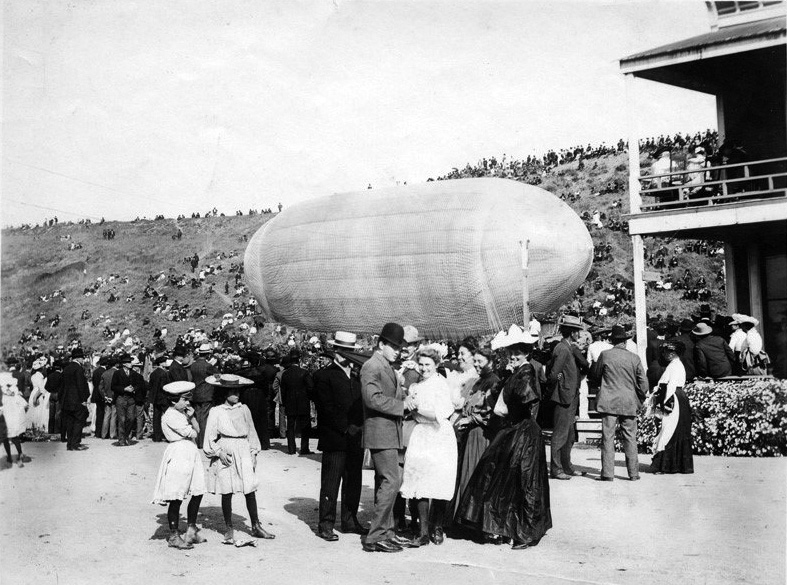 |
|
| (1905)^**^ - Young ladies surround a man (Baldwin?) in a light colored suit with a top hat in front of the Baldwin Airship. |
Historical Notes In 1914 Baldwin built the U.S. Navy's first successful dirigible, the DN-I. He began training airplane pilots and managed the Curtiss School at Newport News, Virginia. One of his students was Billy Mitchell, who would later become an advocate of American military air power. When the United States entered the World War I, Baldwin volunteered his services to the United States Army. He was commissioned a captain in the Aviation Section, U. S. Signal Corps and appointed Chief of Army Balloon Inspection and Production. Consequently, he personally inspected every lighter-than-air craft built for and used by the Army during the war. He was promoted to the rank of major during the war. After the war, he joined the Goodyear Tire and Rubber Company in Akron, Ohio, as a designer and manufacturer of their airships. |
* * * * * |
Dirigible Flights at the Raymond Hotel
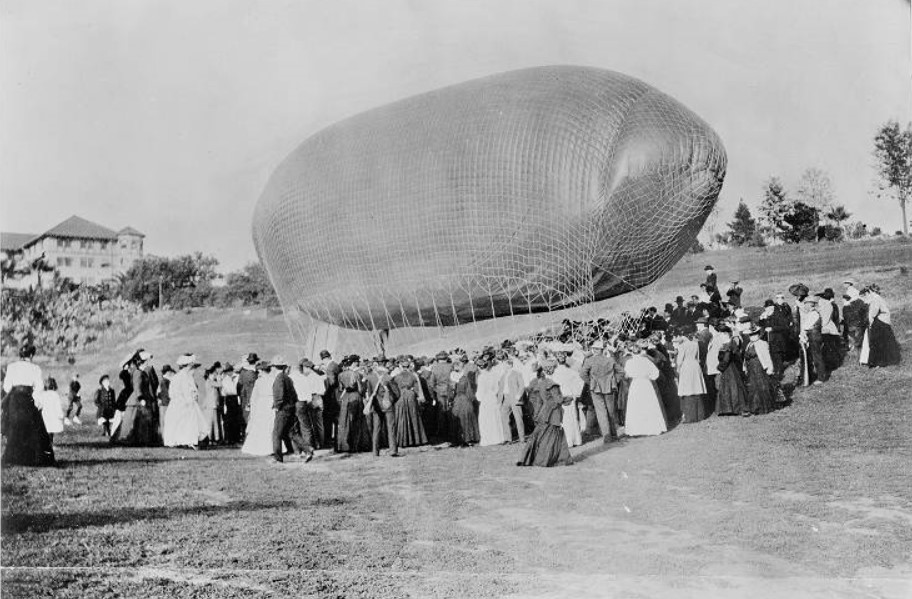 |
|
| (1905)* - View of Roy Knabenshue landing his dirigible on the Raymond Hotel grounds, surrounded by a large crowd of people. |
Historical Notes CA. Roy Knabenshue made outstanding contributions to aviation as an aeronaut making balloon flights. He was among the first to pilot a steerable balloon, one of the pilots of the first successful American dirigible, a builder and exhibitor of dirigibles of his own design, manager of the Wright Brothers’ Exhibition Team, and a leading builder of observation balloons during World War I. |
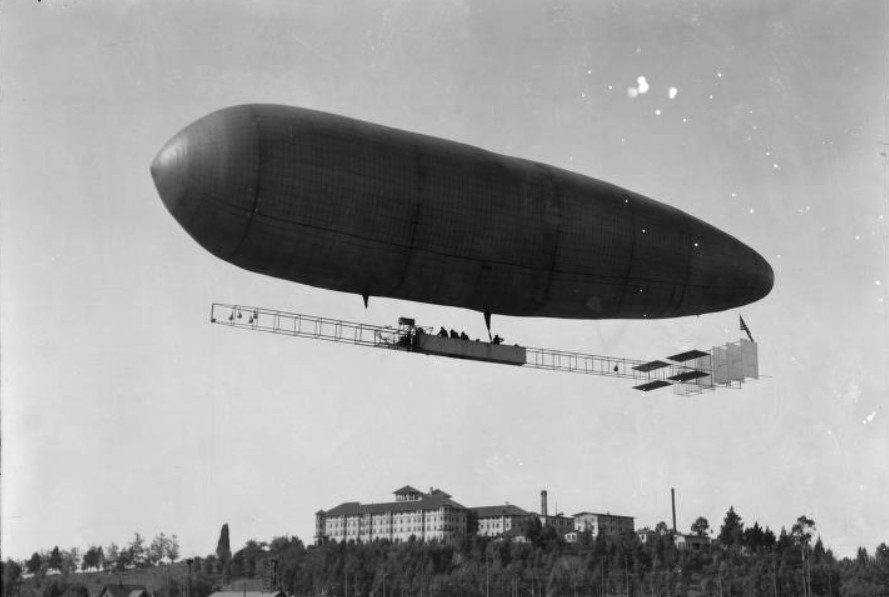 |
|
| (1913)* - A view showing Roy Knabenshue flying his new multi-passenger dirigible with the Raymond Hotel in the background. There are people in the undercarriage which runs the length of the airship. |
Historical Notes Roy Knabenshue was the first to make a dirigible balloon flight over the skyscrapers of New York back in 1905, one year after his original lighter-than- air powered flight at the St. Louis Exposition. After several years of barnstorming and a stretch as general manager for the Wright Brothers, he went west and built a 13-passenger airship in Pasadena for passenger flights. |
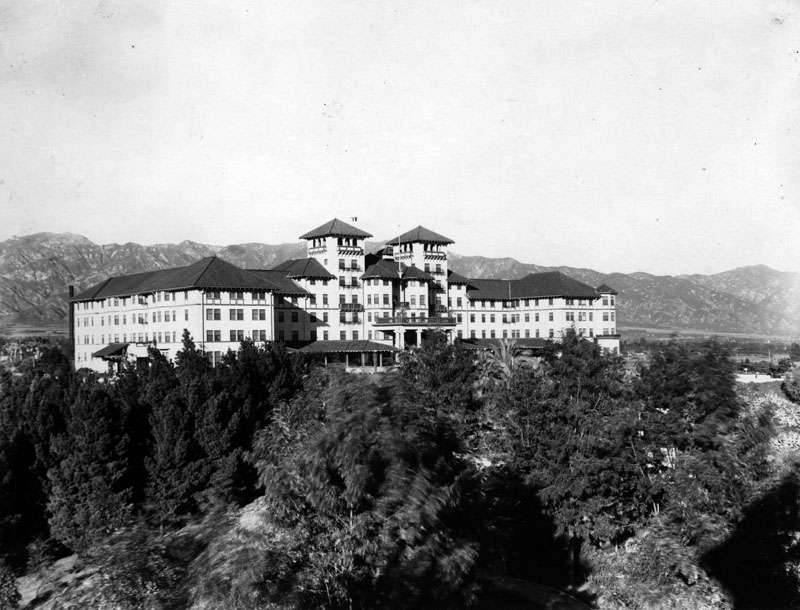 |
|
| (ca. 1910s)* - View of the second Raymond Hotel looking across the grounds at the western facade, the main entrance to the hotel. In the background are the San Gabriel Mountains. |
Historical Notes Located atop Bacon Hill, renamed Raymond Hill, which lies between Pasadena and South Pasadena, the first Raymond Hotel burned down in 1895 and was replaced by a second in 1903.* Click HERE to see more in Early Views of Pasadena. |
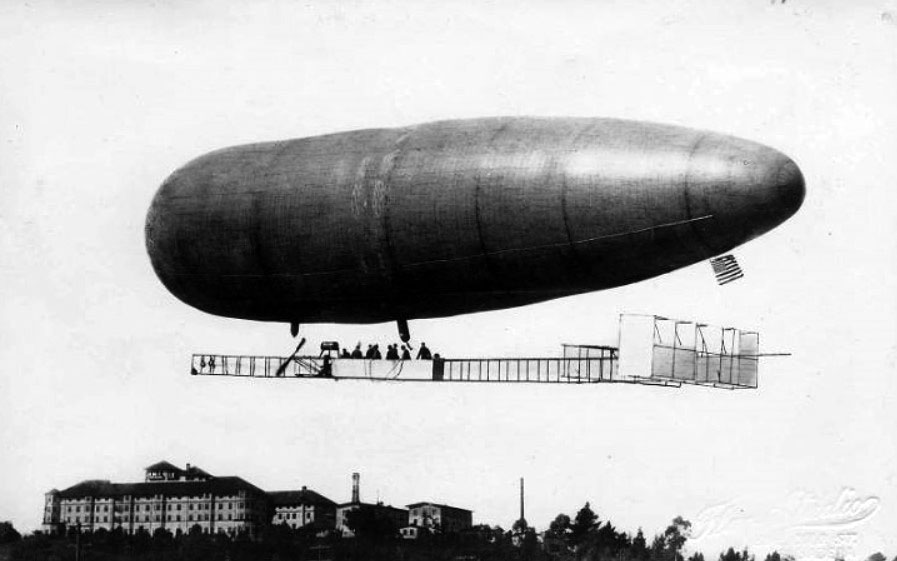 |
|
| (1913)* - Roy Knabenshue flying his 13-passenger dirigible over the Raymond Hotel. He offered aerial tours of the City of Pasadena. |
Historical Notes Click HERE to see more in Aviation in Early L.A. |
* * * * * |
Burdett Airport
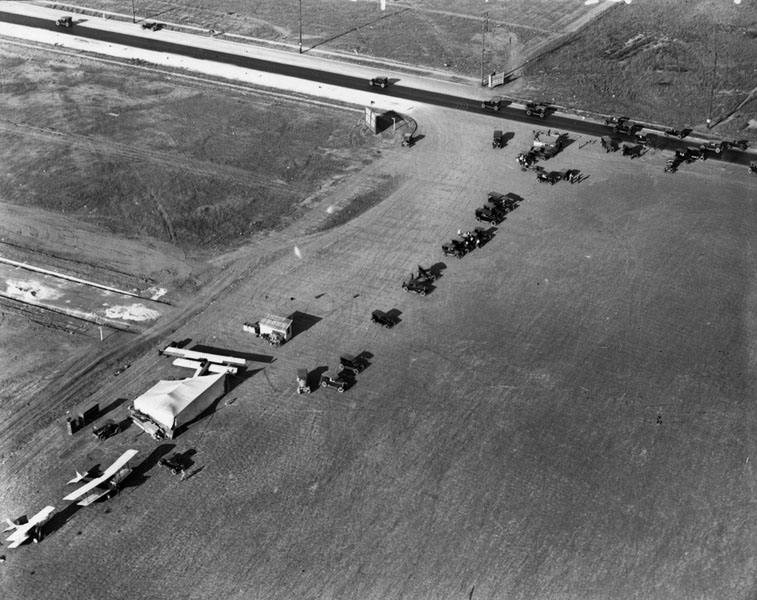 |
|
| (1925)* - Aerial view of Burdett Airport, located at 9401 S. Western Avenue at the intersection of 94th Street and Western Avenue in what is now Inglewood. |
Historical Notes Commercial enterprises in early aviation began to develop after World War I when veteran aviators left the military and saw a future in air travel. Burdett Fuller was a naval reserve flyer who started a flying school and passenger service that grew into an active operation known as Burdett Airport and Burdett Airline located off Western Avenue at 94th Street in Southwestern Los Angeles. Fuller began his airline in 1919 with war surplus Jennys and opened his Burdett Airport in 1922. An historic aviation venture involving Burdett Fuller and Jack Frye was known as the "13 Black Cats" a stunt team working for the pioneer movie industry in the early 1920s. Jack Frye was one of the pilots. They were based at Burdett Airport, reportedly the first private airport in Western United States. *#* |
Black Cats
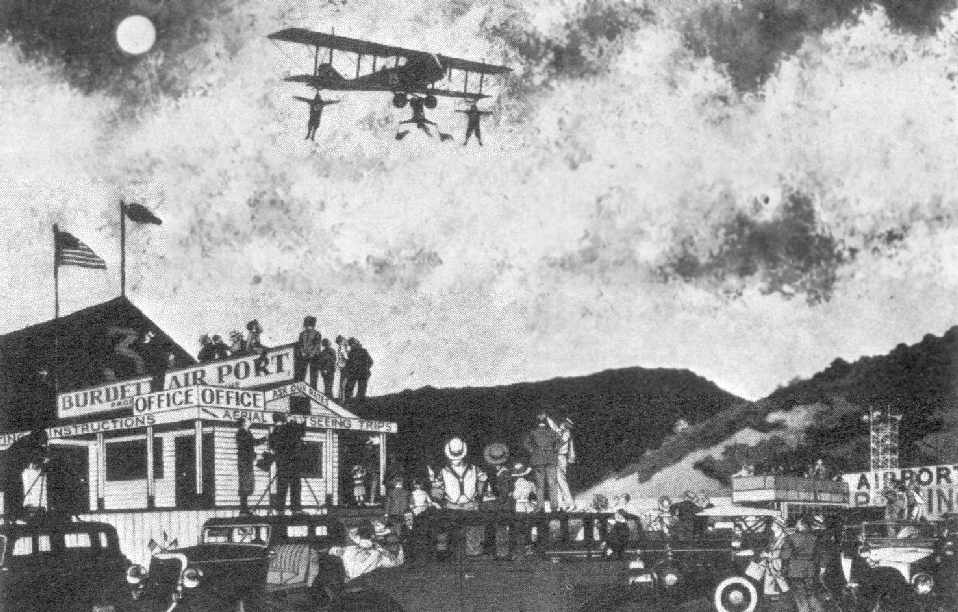 |
|
| (1920s)*# - An illustration of a performance of the "13 Black Cats" at the Burdett Airport. |
Historical Notes The Black Cats were involved with motion pictures and received lots of publicity in the 1920's. Footage of the Black Cats doing their various stunts appeared in many early movies.*^ |
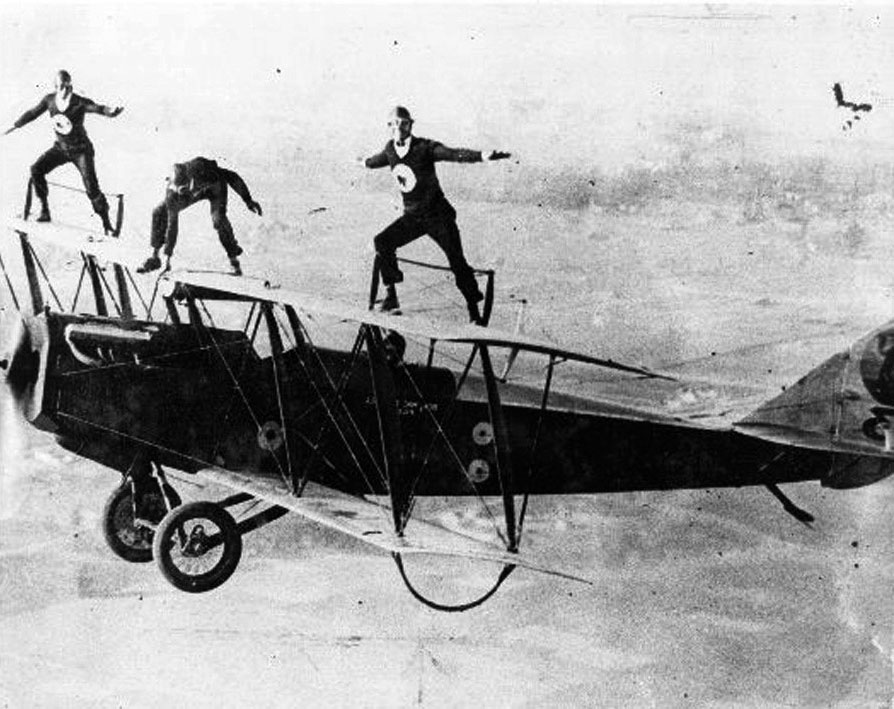 |
|
| (1920s)^# - Three members of the Flying Black Cats stand on the top wing of a bi-plane in flight. |
Historical Notes Their business card says it all, "If a Black Cat can't do it - It can't be done." Their show included motorcycle and car stunts, but their real prowess was in the air, including wing walking with no parachutes, mid-air leaps from one plane to another, flying behind a plane on a tow line, and more. ^# |
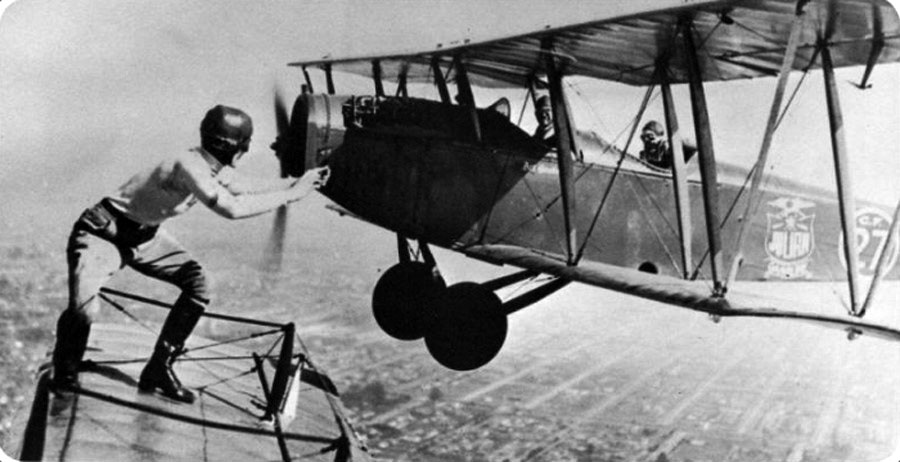 |
|
| (1920s)^# - Flying Black Cats stuntman about to make a mid-air leap from one plane to another without a parachute. |
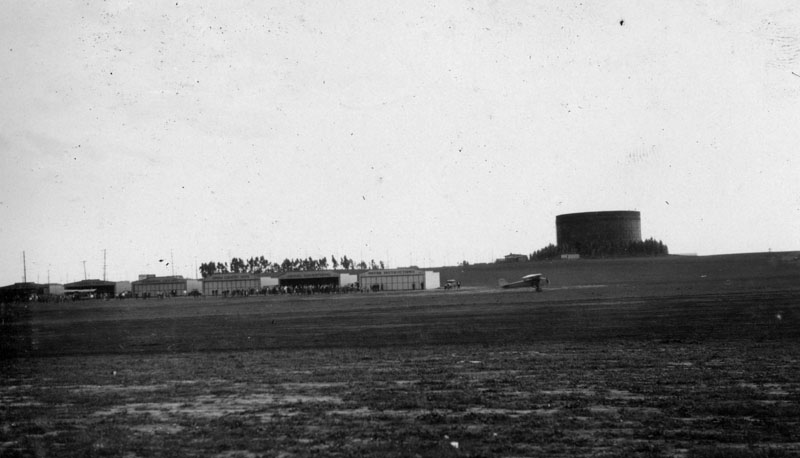 |
|
| (1928)* - View of a large crowd standing near hangars as a plane takes off at Burdett Field. |
Historical Notes The Burdett School of Aviation was established in 1925 by Burdett Fuller and partner Jack Frye to create a base for Burdett Airlines. Eventually Fuller sold the field to Jack Frye, who founded Aero Corp, which later became TWA. Charles Dycer bought the field from Jack Frye in the late 1920s, renaming thge field Dycer Airport.* |
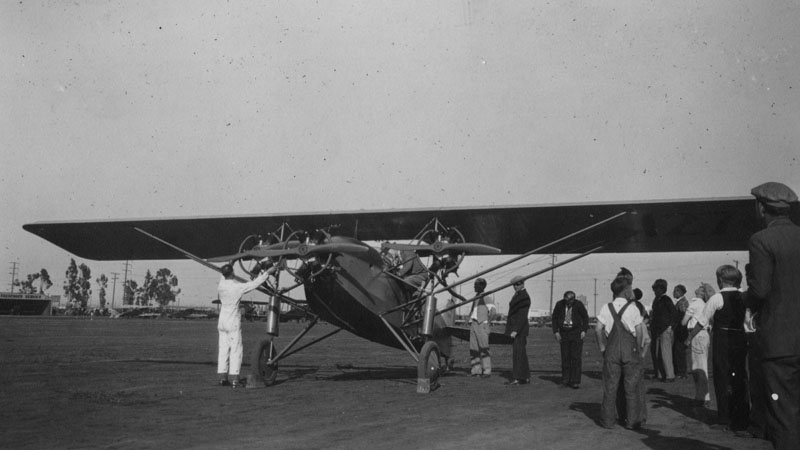 |
|
| (1928)* - A Siemens tri-motor (one at the propeller; one on each side) Brown Mercury plane at Burdett Field. |
Historical Notes Designed by Larry Brown and built in 1927 by the Brown Mercury Aircraft Co. of Los Angeles, the craft was of conventional construction with a wire-graced welded steel tube fuselage, welded steel tube tail surfaces, and a wooden wing, all of which were covered in fabric. The market for this type of plane was small and although reports indicate that it was a good flying machine, production of the aircraft was discontinued during the Great Depression.* |
DeMille Field No. 1 (Melrose and Fairfax)
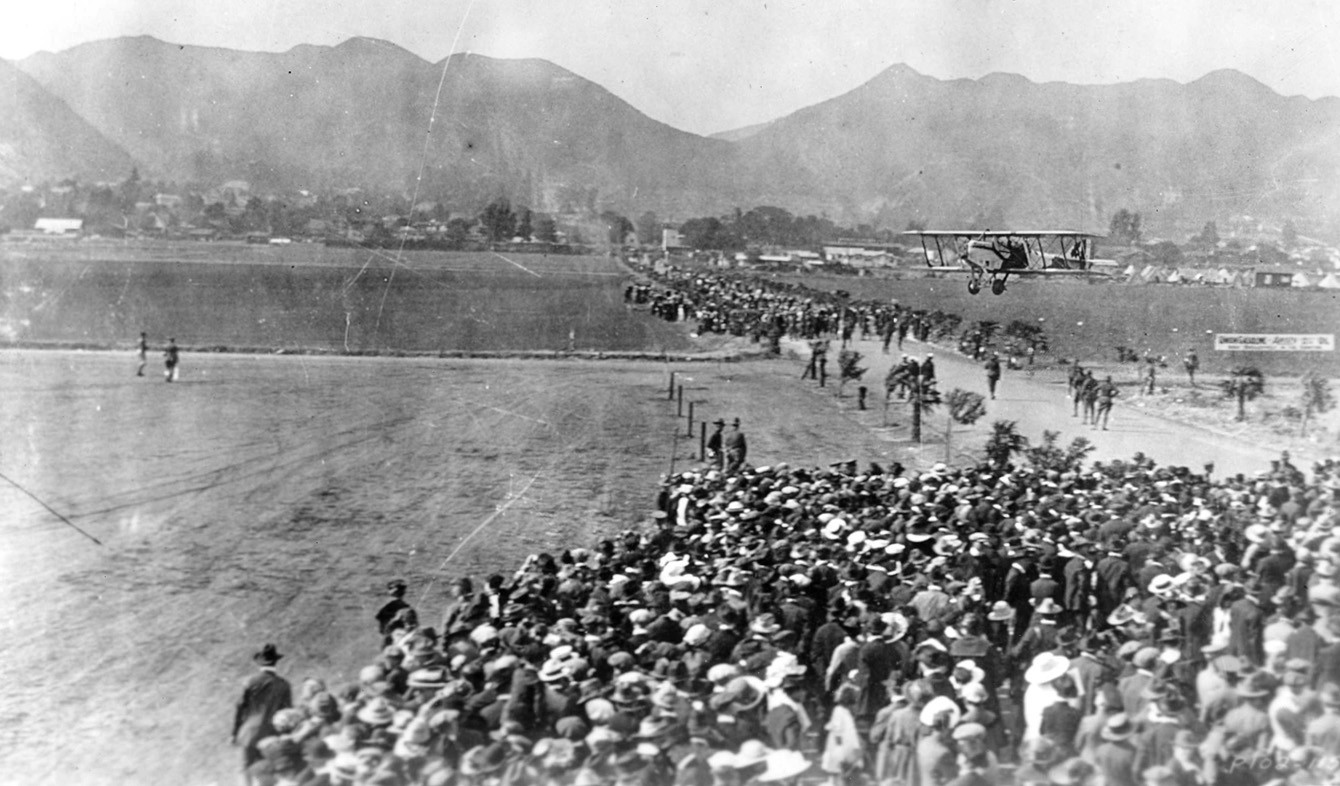 |
|
| (ca. 1919)^ - Crowds of people watch as a bi-plane lands near the southwest corner of Melrose Ave and Crescent Ave (later Fairfax Ave). The view is looking north toward the Hollywood Hills. |
Historical Notes In the late 1910’s prominent members of the Hollywood community were bitten by the flying bug, the most notable being the famed director Cecil B. DeMille and Sydney Chaplin, the older half-brother of Charlie Chaplin. Although business competitors, they pioneered what would become the modern airline industry by offering the first scheduled commercial flights in the world. DeMille, a founder of the Academy of Motion Picture Arts and Sciences, was the most commercially successful director of his time. His credits ranged from the Squaw Man to the Greatest Show on Earth and the Ten Commandments. In 1918 DeMille founded the Mercury Aviation Company and built his first airfield, DeMille Field No. 1, across from the present location of Fairfax High School. |
 |
|
| (ca. 1919)* - View looking southwest showing cars parked along Crescent Ave (later Fairfax Ave) just south of Melrose Ave with the Demille Airfield seen at right. Note the oil wells in the distance. |
Historical Notes In 1919, DeMille would build a second airfield, DeMille Field No.2, and move his enterprise from the field seen above to a new location near the northwest corner of Wilshire Boulevard and Fairfax Avenue (which was then known as Crescent Avenue). |
DeMille Field No. 2 (Wilshire and Fairfax - later Rogers Airport)
 |
|
| (ca. 1920)^* - Aerial view of the intersection of Wilshire Boulevard and Fairfax Avenue looking north during an aviation fair. Automobiles are parked off the roads at the fringes of the open fields that skirt them. Oil fields are visible along with mountains in the background, while at center, people crowd around a collection of airplanes that are situated next to small vendor booths. In a field in the left background (left-center), a building shows a sign which reads "Mercury Aviation Company" (part of DeMille Field No. 2). Chaplin Airfield is seen across Wilshire Boulevard at lower-left. |
Historical Notes In 1919, Cecil B. DeMille built his second airfield (DeMille Field No. 2) on the northwest corner of Wilshire Boulevard and Fairfax Avenue (which was then known as Crescent Avenue). DeMille's first airfield was located on the southwest corner of Melrose and Crescent avenues. Cecil B. DeMille founded the Mercury Aviation Company (aka Mercury Air Lines ) in 1919. Mercury was the first American airlines to carry air freight and passengers commercially on regularly scheduled runs. It scheduled service to Santa Catalina Island and San Diego, later San Francisco, with Junker-Larsen JL-6 monoplanes. Inaugurated five months before KLM began operations in Europe.^^ Mercury’s competitor in the air travel business was across the street at Chaplin Airfield, which was founded in 1919 by Sydney Chaplin. Chaplin was a stage performer and silent film actor before becoming his far more famous sibling’s business manager. |
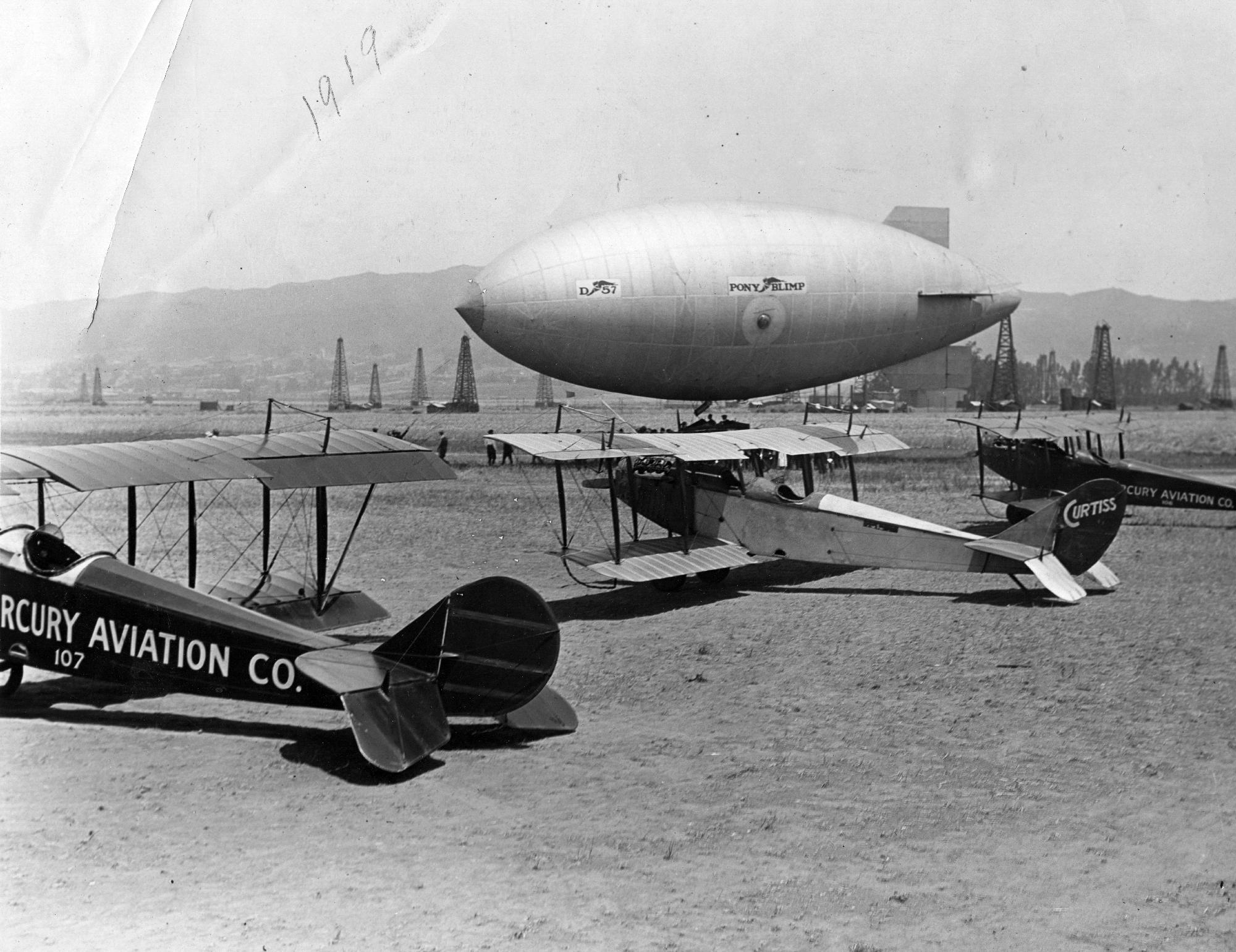 |
|
| (ca. 1920)^*# - View looking northeast showing DeMille Airfield No. 2 at Fairfax and Wilshire (NW corner). Three planes sit on the field in the foreground while a blimp hovers just beyond them. One of the planes has "Mercury Aviation Co." written on its side. Oil derricks belonging to the Gilmore family are seen in the background. |
Historical Notes Cecil B. DeMille had already pioneered one Los Angeles industry, and in 1920 he was on the cusp of launching another: as president of the newly formed Mercury Aviation Company, DeMille was pursuing the ambitious goal of inaugurating regularly scheduled airline service between Los Angeles and other West Coast cities. Mercury’s headquarters: a barley field at the northwest corner of Wilshire and Fairfax (then Crescent Ave.) where the company had cleared a primitive runway, built a hangar, and opened a filling station that refueled airplanes on one side and automobiles on the other. The aerodrome doubled as a shooting location for aviation stunts, but the real stars here were Mercury’s fleet of Junkers-Larsen monoplanes. Built of lightweight corrugated aluminum, the planes could soar to altitudes of 20,000 feet, propelled by a single 185-horsepower engine. And thanks to a sealed cabin, passengers could fly without goggles and other special gear. ##* |
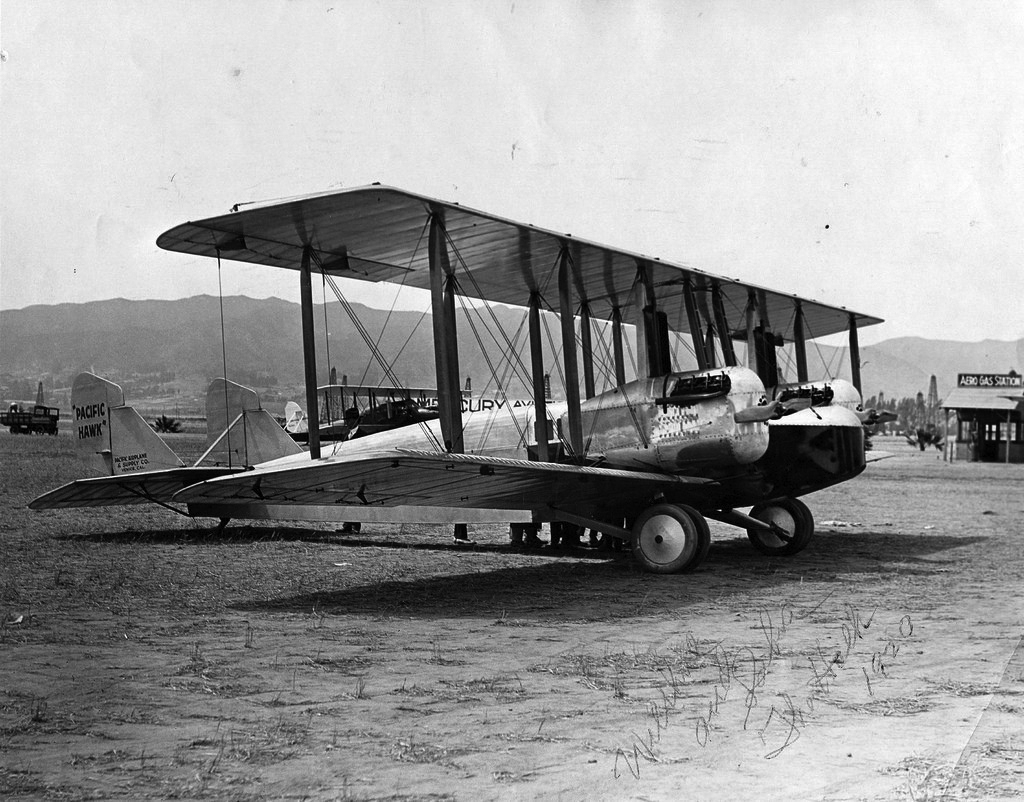 |
|
| (1920)^*# - View showing one of Mercury Aviation's Junker-Larson airplanes at DeMille Airffield No. 2. |
Historical Notes Built of lightweight corrugated aluminum, the planes could soar to altitudes of 20,000 feet, propelled by a single 185-horsepower engine. And thanks to a sealed cabin, passengers could fly without goggles and other special gear. In the two years or so it was in operation, Mercury transported over 25,000 passengers without a single injury – but flying was expensive and still too much of a novelty to be fully embraced by the traveling public. The Mercury Aviation Company proved to be unprofitable and DeMille shut down the airline by 1922. |
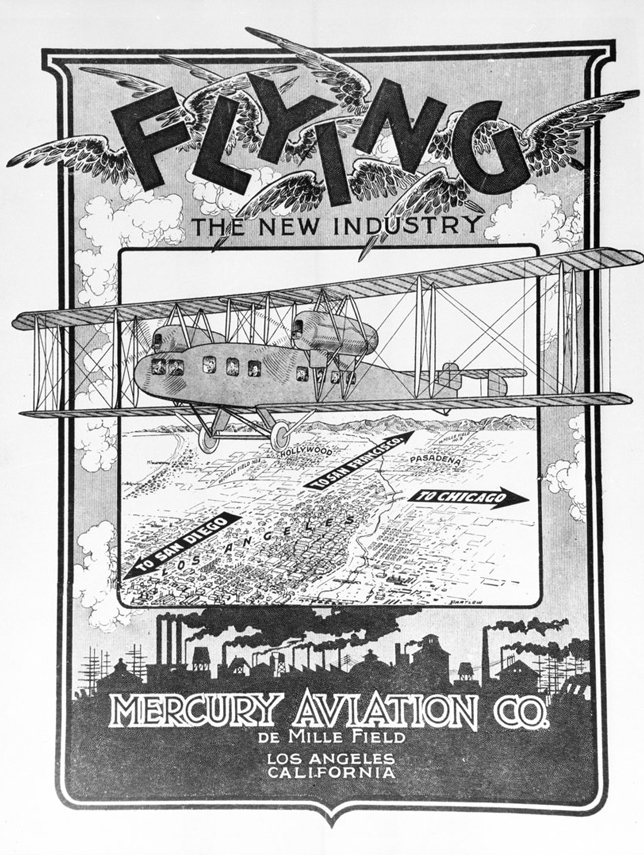 |
|
| (ca. 1922)^* - Photograph of an advertisement for Mercury Aviation Company, located at DeMille Field. |
Historical Notes A bi-plane with people looking out the windows is depicted centrally. Above are the words, "Flying", in large block letters with wings atached and the words "The New Industry". Below, a map features Los Angeles with arrows pointing three different directions, each with one of the following locations, San Diego, San Francisco, and Chicago. Further below is what appears to be a silhouette of an industrial city with smoke stacks, powerlines, and oil derricks, with the words "Mercury Avation Co., De Mille Field, Los Angeles, California". Photoprint reads: "As illustrated in the picture, DeMille operated three fields in the LA area. #2 (not shown) was north of the Wilshire/Fairfax intersection. At the time (early 1920s), DeMille was the largest aviation operator in the LA area and his thoughts began to turn toward the establishment of a scheduled airline to San Francisco and San Diego".^* |
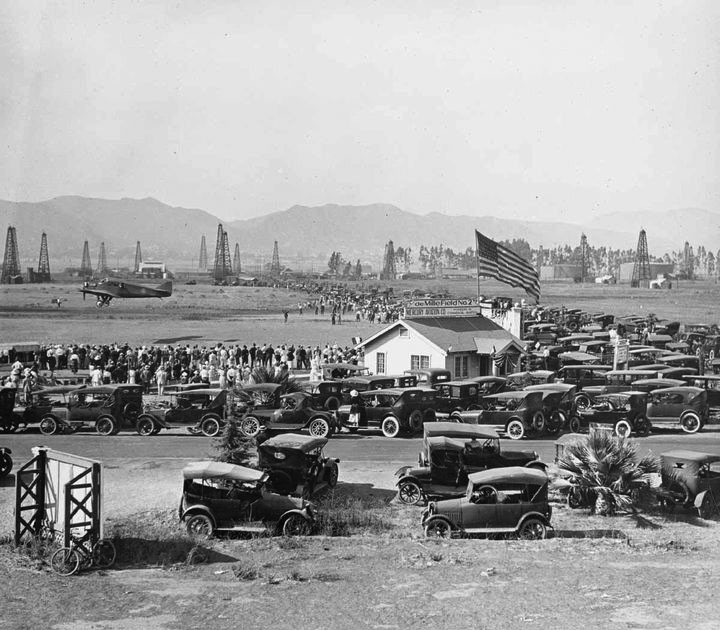 |
|
| (ca. 1920)^ - Parking lot is full as crowds attend air show at DeMille Field No. 2. The sign on top of the structure with the large American Flag reads: DeMille Field No. 2. View is looking northeast near the NW corner of Wilshire and Fairfax. |
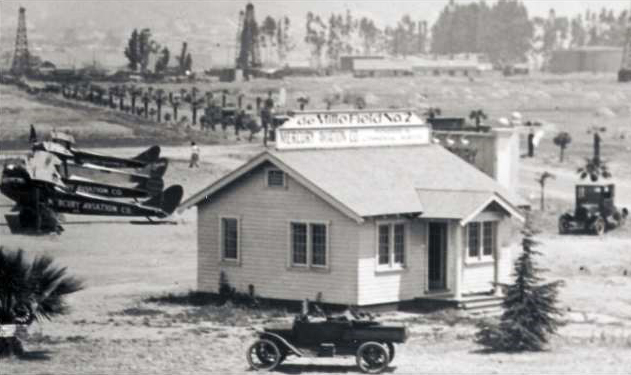 |
|
| (ca. 1920)* - Closer view of the main office at DeMille Field No. 2 located near the northwest corner of Wilshire and Crescent (Fairfax). The airfield was home to Mercury Aviation Co. |
Historical Notes The Mercury Aviation Company proved to be unprofitable and DeMille shut down the airline by 1922. He sold his airfield to Emery H. Rogers, owner of Rogers Aircraft Inc. |
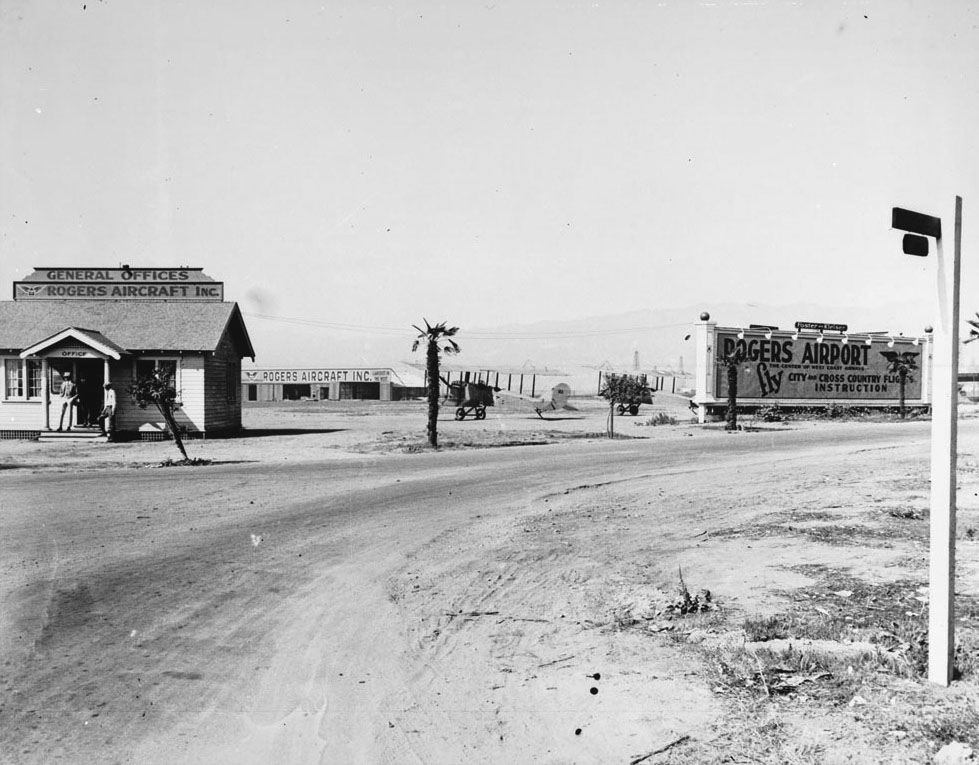 |
|
| (1922)^* - View of Rogers Airport (previously DeMille Field No. 2) looking west toward the general office and hangars with a large billboard sign that reads: "Rogers Airport. The Center of West Coast America. Fly City and Cross Country Flights. Instruction". The small clapboard building at the left edge of the image bears a sign reading "General Offices. Rogers Aircraft Inc." Two men stand on the building's steps, one of whom may be Jim Webster, the airport manager. Two airplanes sit at center, in the open land behind the sign, while the hangar sits in the left background. |
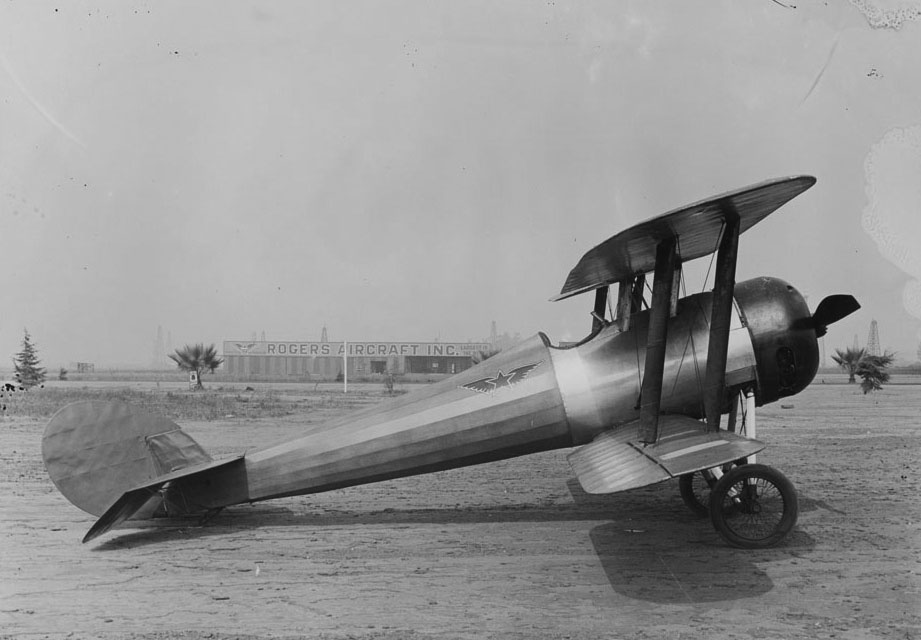 |
|
| (ca. 1922)^* - Airplane parked at Rogers Airport with Rogers Aircraft Incorporated building in the background. |
Historical Notes By 1931 Rogers Field had disappeared from street maps. Land was becoming too valuable and the area would see a surge in development. The old Rogers Field would soon become the western end of the Miracle Mile. |
Chaplin Airfiled (later Rogers Airport)
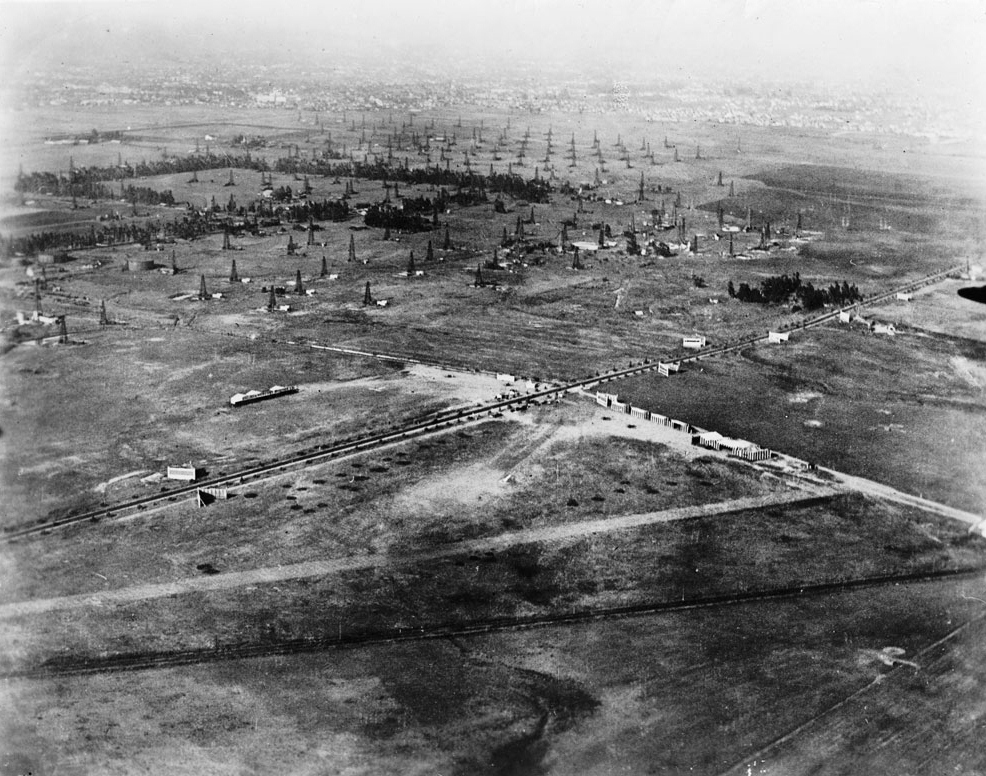 |
|
| (1920)* - Aerial view of Crescent Avenue (now Fairfax) and Wilshire Boulevard in 1920 showing undeveloped land with many oil derricks. In the lower part of the photograph is Chaplin Airport. The tree-lined street is Wilshire. The diagonal line at the bottom is actually railroad tracks that would later become San Vicente Bouelvard. |
Historical Notes Chaplin Airfield was located on leased property that is now bounded by Wilshire Boulevard, Fairfax Avenue, and San Vincente Boulevard. The Syd Chaplin Aircraft Corporation advertised that it “maintained a fleet of newest Curtis one and two-passenger aeroplanes, large shops with complete equipment and hangars for our own ships as well as those belonging to business firms and individuals.” Syd Chaplin was the brother of famed actor Charlie Chaplin. |
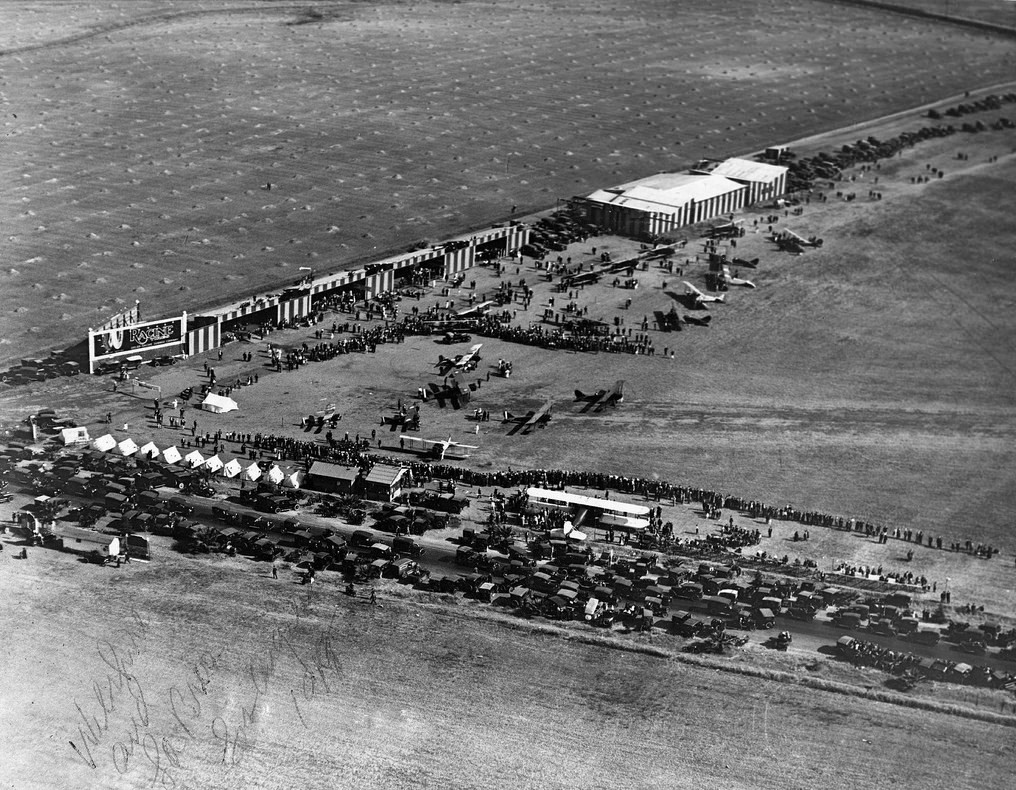 |
|
| (1919)^* - Aerial view looking southeast showing crowds of people at Sid Chaplin's airport at the southwest corner of Wilshire Boulevard and Crescent Avenue (now Fairfax Avenue). Dozens of cars are parked in rows in the foreground, with several airplanes parked behind them in the more open field. A vendor tent is visible farther up the image, near more parked cars. A billboard to the left reads "Racine Tires". |
Historical Notes The Chaplin Aircraft Company offered observation flights for $10 and round-trip flights to San Diego for $150 (at a time when the average wage was $1,200 per/year). Obviously, the cost of air travel was very steep and Chaplin’s enterprise had a brief life span. Around 1920 Chaplin sold out to Emory H. Rogers, a business partner, who renamed it Rogers Field. |
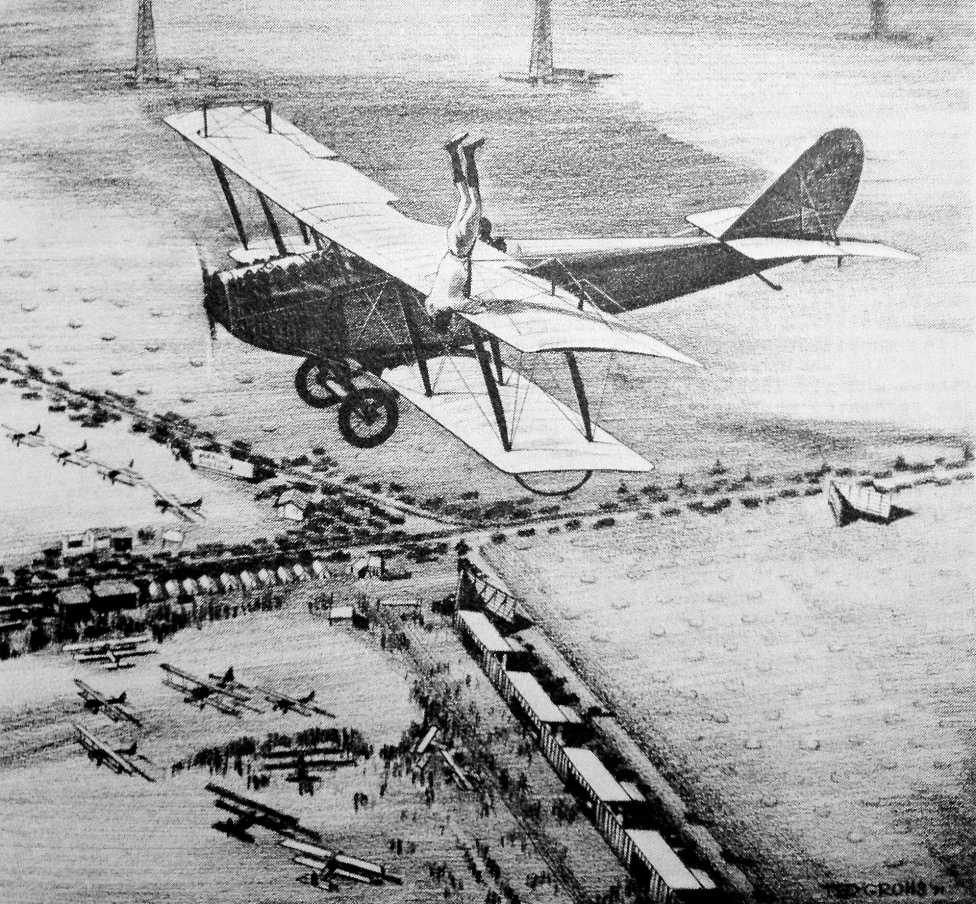 |
|
| (n.d.)*# - An undated painting by Ted Grohs of Omar Locklear during a headstand on the wing of a Jenny above the De Mille & Chaplin Airports on Wilshire Boulevard & Crescent Avenue (now Fairfax Avenue). DeMille Airport is located on the NW corner (center-left) and Chaplin Airpot is on the SW corner (lower-left). |
Historical Notes Chaplin Airport (also known as Chaplin Airdrome) became Rogers Airport circa 1920. |
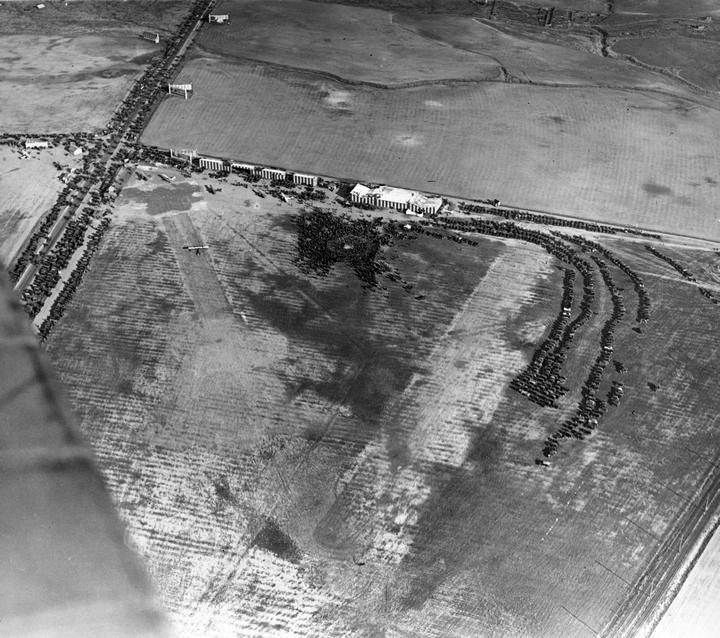 |
|
| (ca. 1922)^ – Aerial view looking down at the Chaplin Airdrome with the intersection of Crescent Ave (later renamed Fairfax Ave) and Wilshire Blvd. |
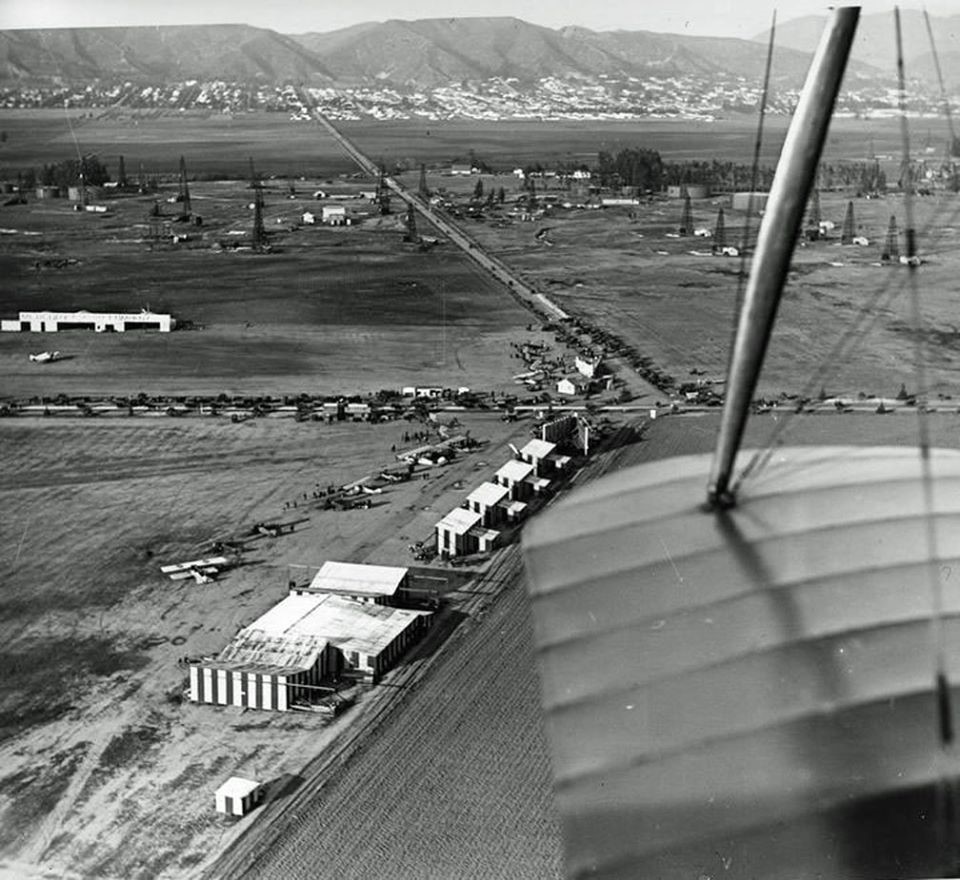 |
|
| (ca. 1922)^ - View looking north over the wing of a bi-plane showing the intersection of Crescent Ave (Fairfax) and Wilshire Blvd. A crowded airfield (now Rogers Airfield) is seen below. In the distance oil derricks are seen at Fairfax Avenue where 6th Street is located today. In the far background, at the foothills, can be seen a built-up Hollywood. |
Historical Notes By 1922 both Chaplin Airfield (S/W corner) and De Mille Field No. 2 (N/W corner) would be owned by Emery H. Rogers, owner of Rogers Aircraft Inc. They would be part of Rogers Airfield which straddled Wislhire Boulevard west of Farifax Avenue. |
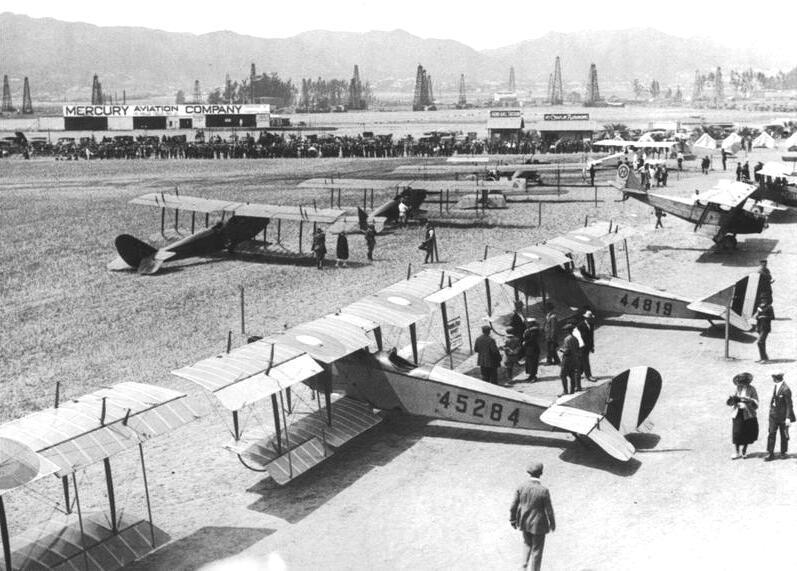 |
|
| (ca. 1922)^ - Ground view of Rogers Airfield (previously Chaplin Field) on the southwest corner of Fairfax and Wilshire. The Mercury Aviation Company sign can be seen on a hangar on the north side of Wilshire Boulevard at the DeMille Airfield No. 2., which would also become part of Rogers Airfield in 1922. |
Historical Notes Rogers Field was touted as the largest airfield in the west and continued in operation for about ten years. Rogers offered free use of the field to the City of Los Angeles as a municipal airport, but the surrounding real estate was rapidly becoming too valuable. |
 |
|
| (1922)*# - View looking west over Wilshire Boulevard at Crescent Avenue (later Fairfax Ave). Rogers Airfield can be seen straddling Wilshire Blvd at center of photo. Crescent Ave (later Fairfax Ave) runs horizontally at bottom. The diagonal line (upper-left) are railroad tracks (today, San Vicente Boulevard). |
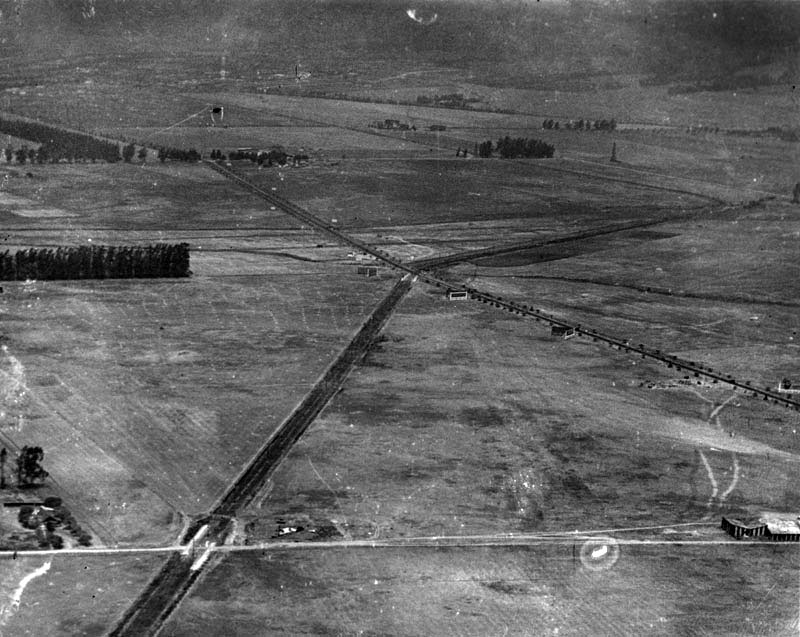 |
|
| (1922)* - Aerial view of Carthay Center, looking west across field of the first Rogers Airport at Wilshire Boulevard and Fairfax Avenue (lower right of photo). Wilshire Boulevard is the tree-lined street seen in the center of the image. The diagonal line running from lower left to upper right is the San Vicente line of the Pacific Electric Railway, later to become San Vicente Boulevard. |
Historical Notes In 1922, J. Harvey McCarthy developed an upscale residential district along the San Vicente Boulevard line of the Pacific Electric Railway, bounded by Wilshire Blvd. on the north, Fairfax Avenue on the east, Olympic Blvd. on the south and Schumacher Drive on the west. McCarthy originally named the district Carthay Center (Carthay being a derivative of the developer's last name). The areas to the south of Olympic Boulevard remained undeveloped until 1933, when developer Spyros George Ponty built several hundred homes in two districts later named "South Carthay" and "Carthay Square." *^ |
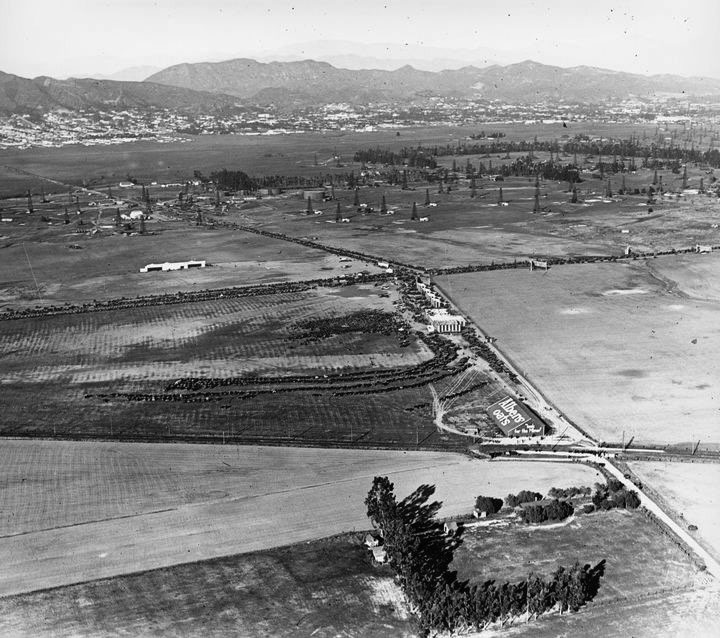 |
|
| (ca. 1922)^ - View looking north shows numerous cars parked on a lot (center of photo) near the Rogers Airfield as well as along Wilshire Blvd. and Crescent Ave (Fairfax). Large sign on building in the lower-right center at the intersection of Fairfax and the San Vicente line of the Pacific Electric Railway reads: Albers Oats. |
Arcadia Balloon School - Ross Field
.jpg) |
|
| (ca. 1918)^* - Photograph of a large airship being held down by men, perhaps at a military "balloon school" in Arcadia, ca.1918. Hovering several feet above the ground, the airship tilts toward the left slightly. Below it to the right, several people hold onto a rope connected to the ship, anchoring it. Behind the people are a series of barrack-like buildings. Beyond this, an arborous area can be seen, followed by the mountains in the distance. |
Historical Notes Opened in 1918, the Arcadia Balloon School was built to train U.S. Army balloon observation troops for World War I. Before any graduates arrived in Europe, the war ended.^^# |
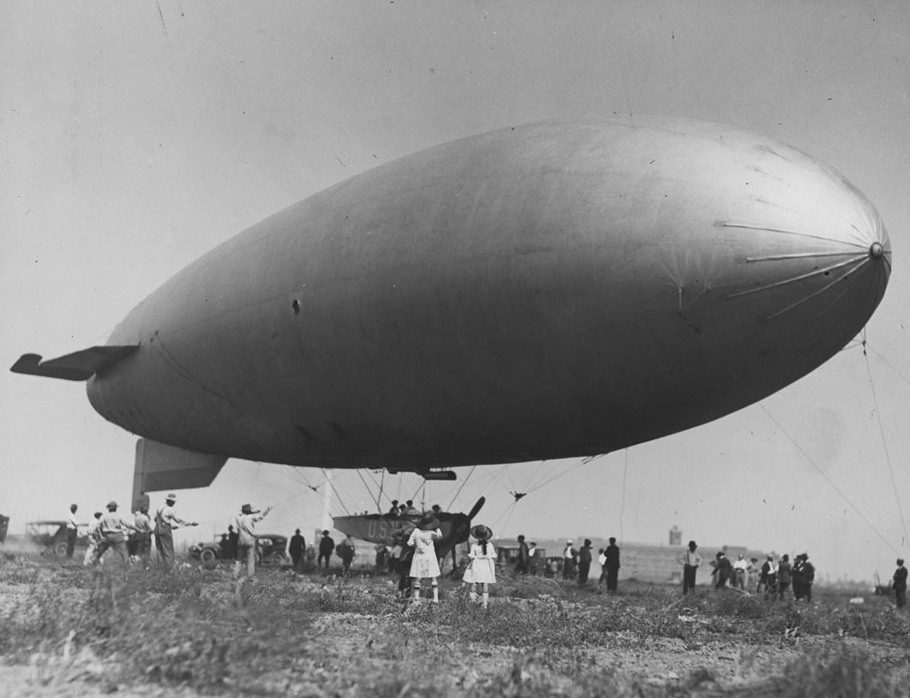 |
|
| (ca. 1918)^* - View of a large airship being held down by cables as spectators surround it at a "balloon school" in Arcadia. The aircraft hovers slightly above the ground, pointing right, with several passengers on board. A crowd of spectators gathers around the craft, and two young girls in light-colored dresses and bonnets stand in the foreground. Several men on the left pull a cable to keep the ship on the ground. A structure is visible in the distance, while the foreground is composed of a grassy field. The background is neutral. |
Historical Notes In November 1918, the base was renamed Ross Field, honoring Lt. Cleo J. Ross of the U.S. Army 8th Balloon Company, killed in action in France. U.S. Army balloon operations continued at Ross Field for a few years, but by the mid-1920s, the base was closed. Today it’s the site of Arcadia County Park and Golf Course.^^# |
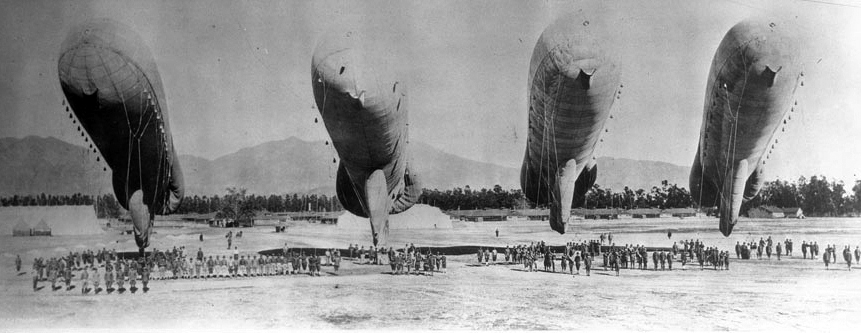 |
|
| (ca. 1918)^* - Panoramic view showing four dirigibles at the balloon school in Arcadia. The four large airships are floating low to the ground and are tethered down by large ropes. Uniformed soldiers can be seen on the ground beneath the large balloons. In the background, a line of tall trees stretches across the image, while tall mountains can be seen further in the distance. |
 |
|
| (1921)^^# - Three U.S. Army balloons prepare for launch from Ross Field. |
Brand Field - Glendale
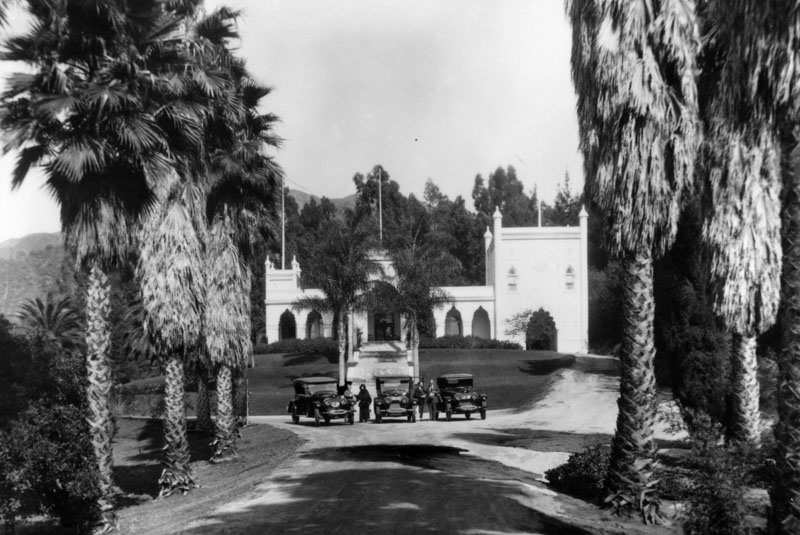 |
|
| (ca. 1920)* - View of El Miradero and estate grounds, once home to Leslie C. Brand. Three vehicles are seen parked next to one another where the driveway and path to the front door meet. Brand built an airfield on his property to fly in guests for his elaborate partys. |
Historical Notes Born in Missouri in 1859, Leslie Coombs Brand became the sole provider for his family at age 11. In 1886, Brand came to California to take advantage of its first boom period. Brand was a major figure in the settlement and economic growth of the Glendale area. He had purchased land on the lower slopes of Mount Verdugo overlooking the city, and in 1904 built an imposing residence that became known as Brand Castle (aka El Miradero), which today houses the Brand Library. He also built his own private airfield.*^ |
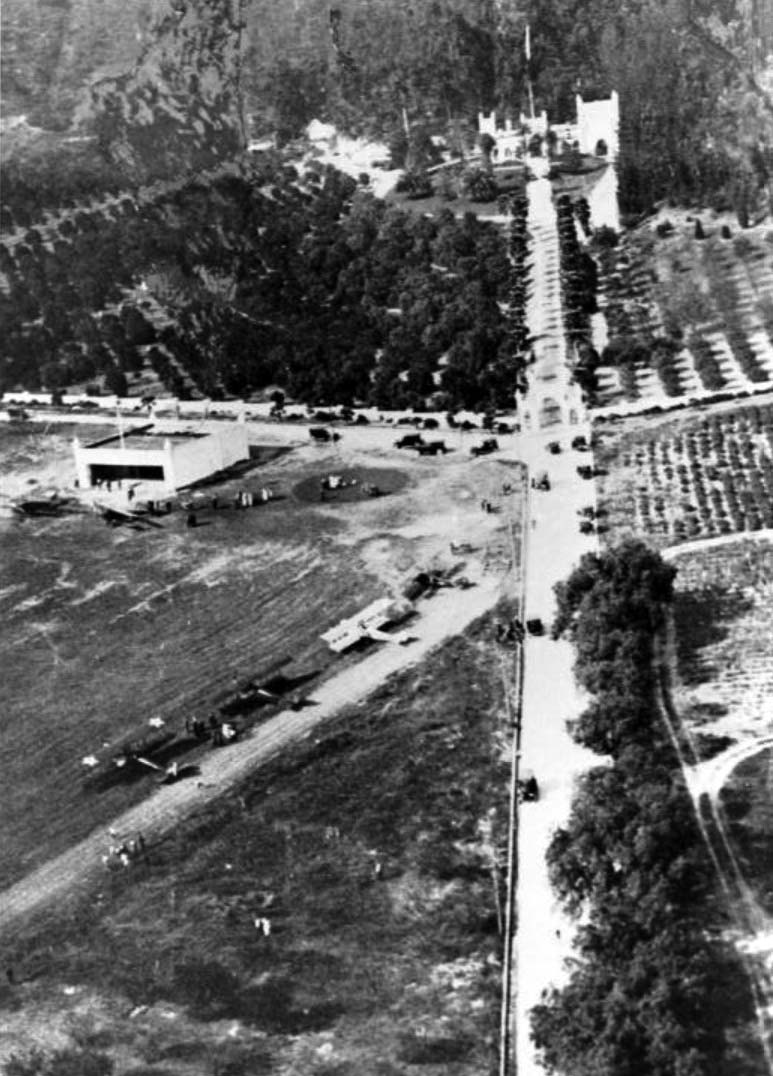 |
|
| (1921)^ - An aerial view of L. C. Brand's airfield in front of his home, El Miradero in Glendale. The airplanes took off downhill toward Kenneth Road. |
Historical Notes Brand established a grassy, well-manicured airfield in front of the mansion. The airfield consisted of a 1,200' rolled dirt runway, with a white hangar at one end and a putting green on the other. The hangar matched the architectural style of the mansion - with turrets atop each of the 4 corners.*# |
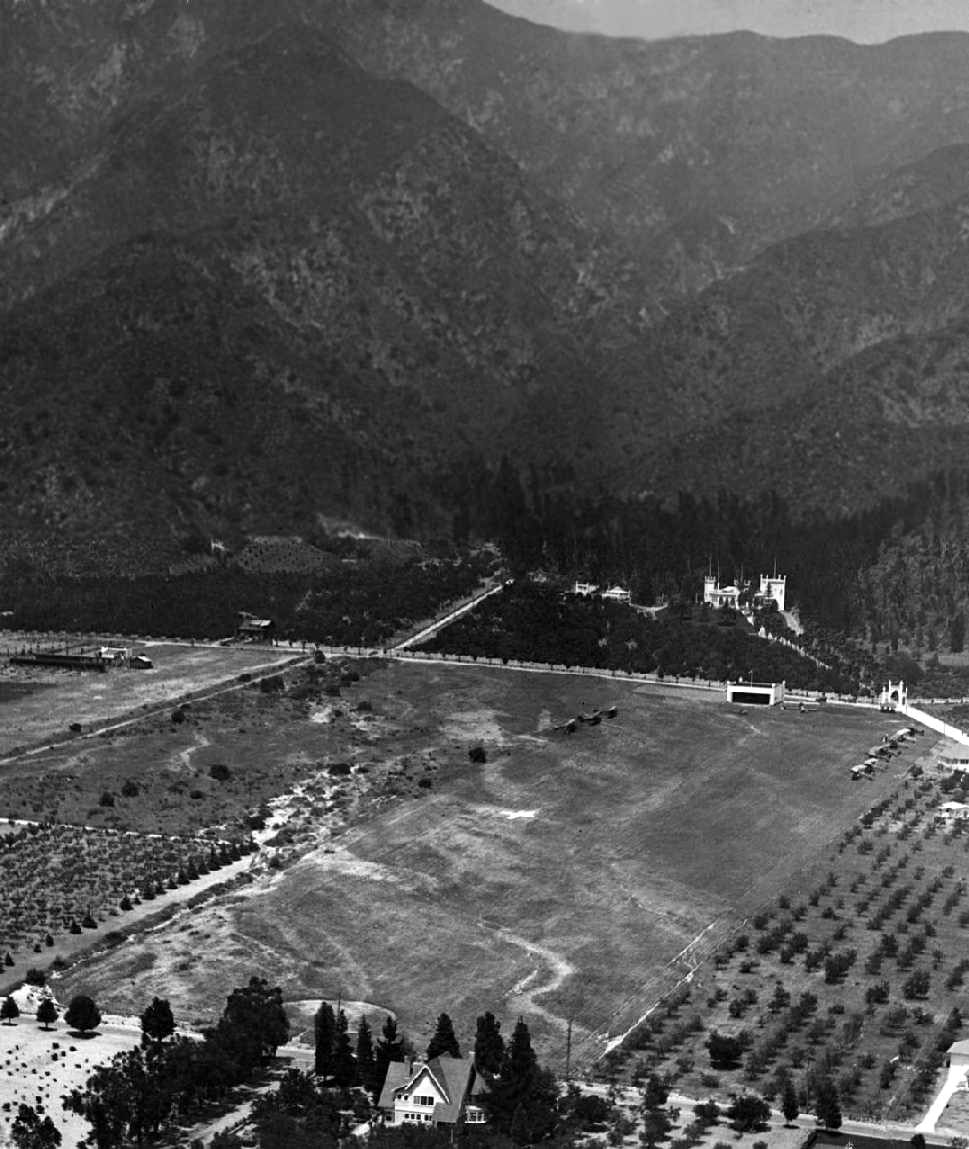 |
|
| 1923)*# – Aerial view looking north at Brand Field, showing the hangar and 10 aircraft on the field, and the mansion across the street. Note the steep terrain – obviously takeoffs to the north wouldn't be advisable. |
Historical Notes Only 3 aircraft are known to have been actually based at Brand Field. However, Brand apparently bought many war surplus Jennies, some to tinker with and fly as a sport, although most languished in storage buildings.*# |
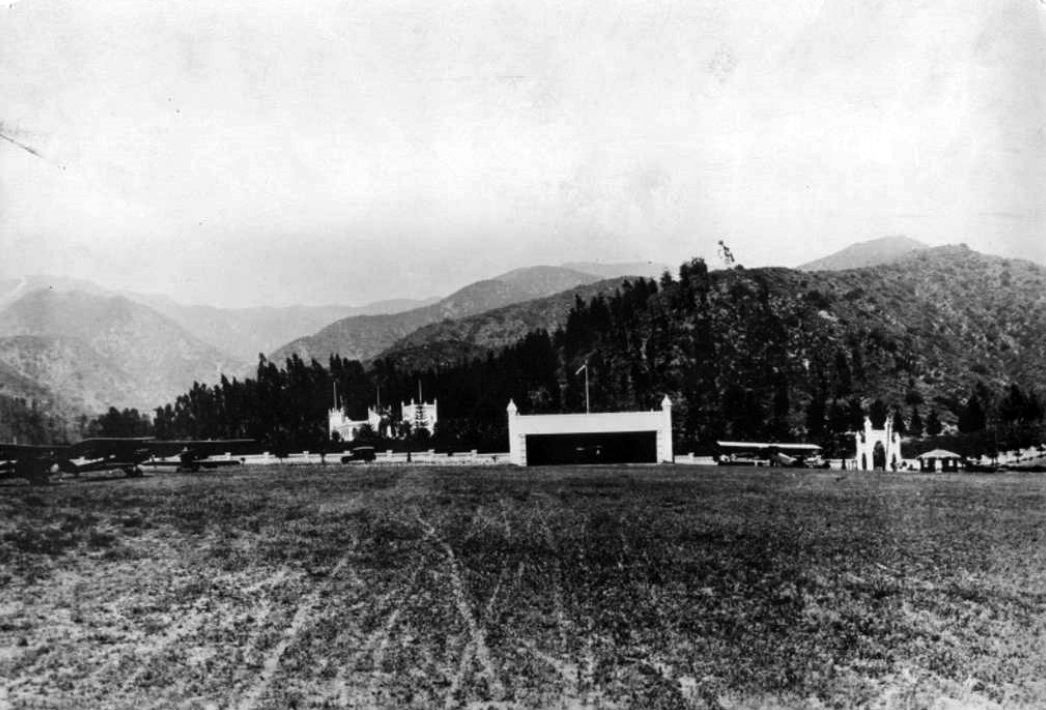 |
|
| (ca. 1920s)^**^ – View of Brand Airfield from ground level. Both the Moorish-style mansion and hangar can be seen in the distance. |
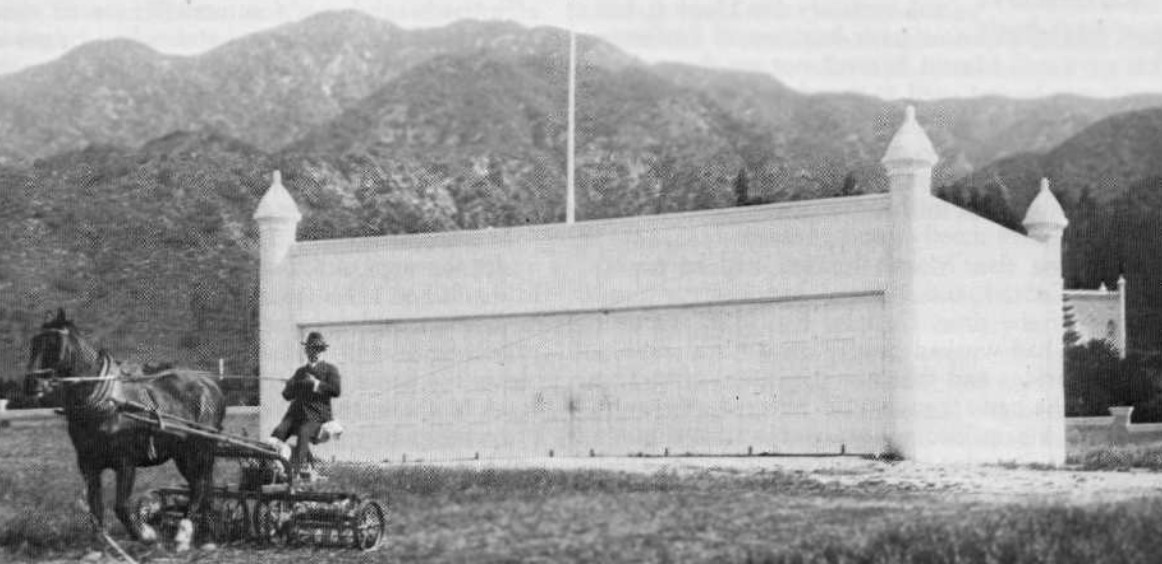 |
|
| (ca. 1920s)*# – View of millionaire Leslie C. Brand mowing the lawn in front of the Moorish-style hangar at his private Airfield. |
Historical Notes Brand built his first hangar in 1916 and put together a fleet of planes, and held fly-in parties. The only requirement was that guests had to arrive in their own planes and bring passengers.*^ |
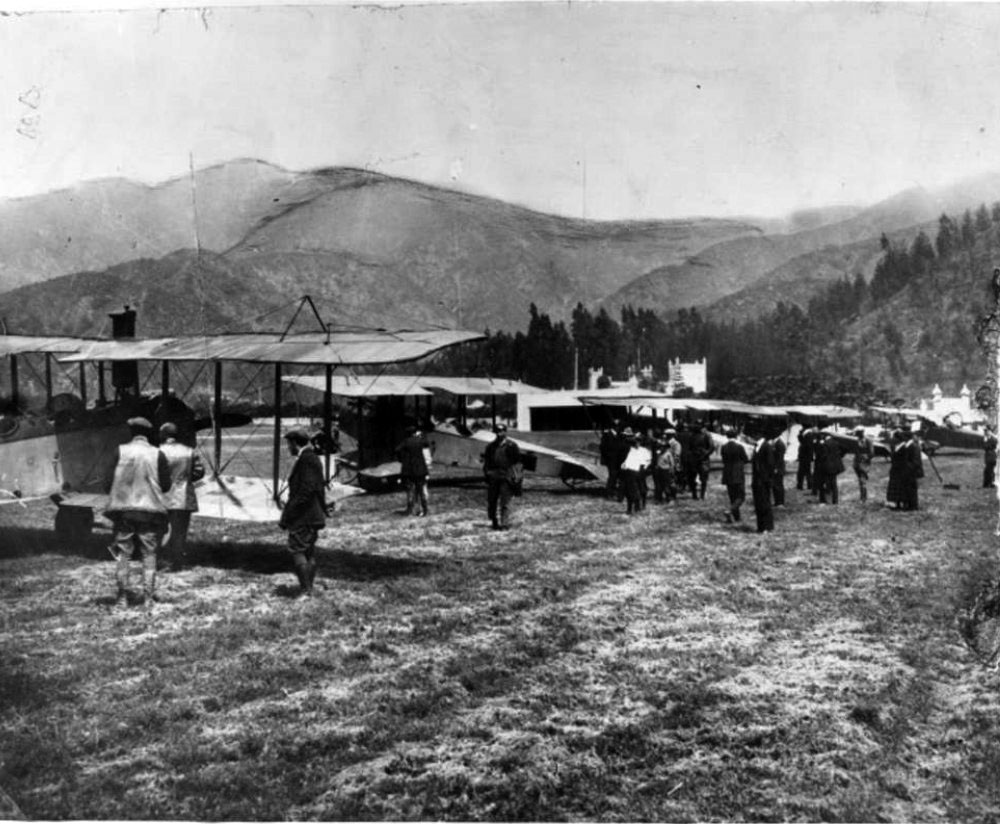 |
|
| (1921)^**^ – Several airplanes and guests arriving at Brand's fly-in luncheon party on April 1, 1921. El Miradero Mansion is seen in the background. |
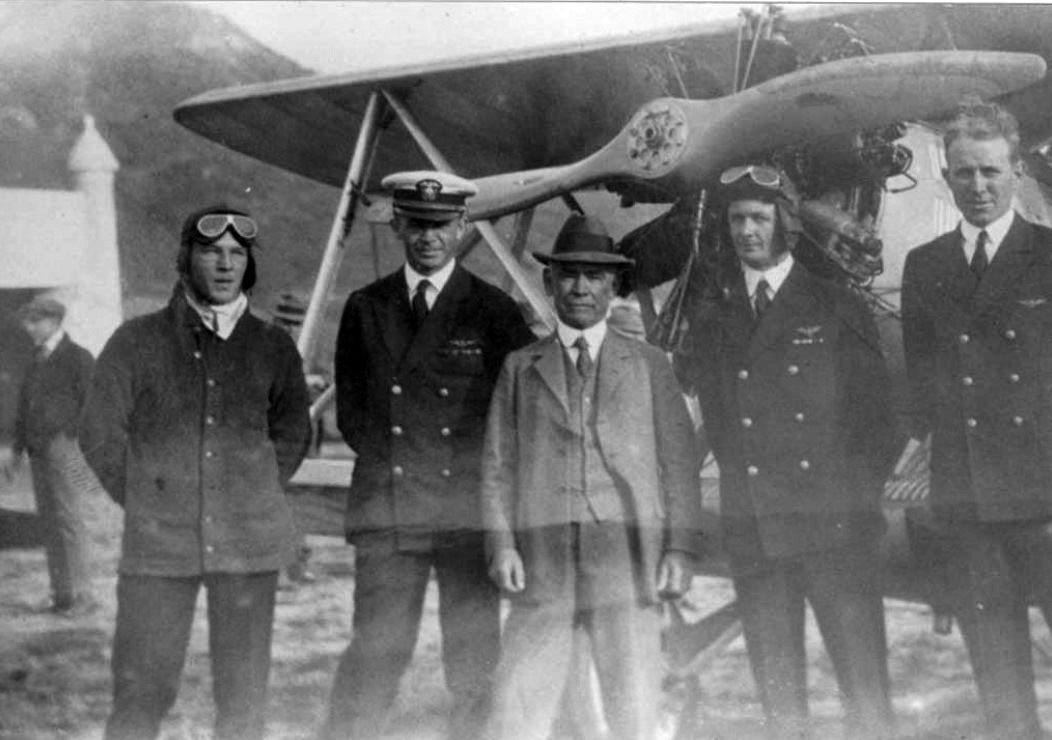 |
|
| (1921)^**^ – View of Leslie C. Brand and pilots at fly-in party. |
Historical Notes Leslie C. Brand helped develop the city of Glendale. Together with Henry E. Huntington, he brought Pacific Electric to the town to develop it. The 'Brand Library' section of the Glendale Public Library is named in his honor. Brand Boulevard in Glendale is also named in his honor.*^ |
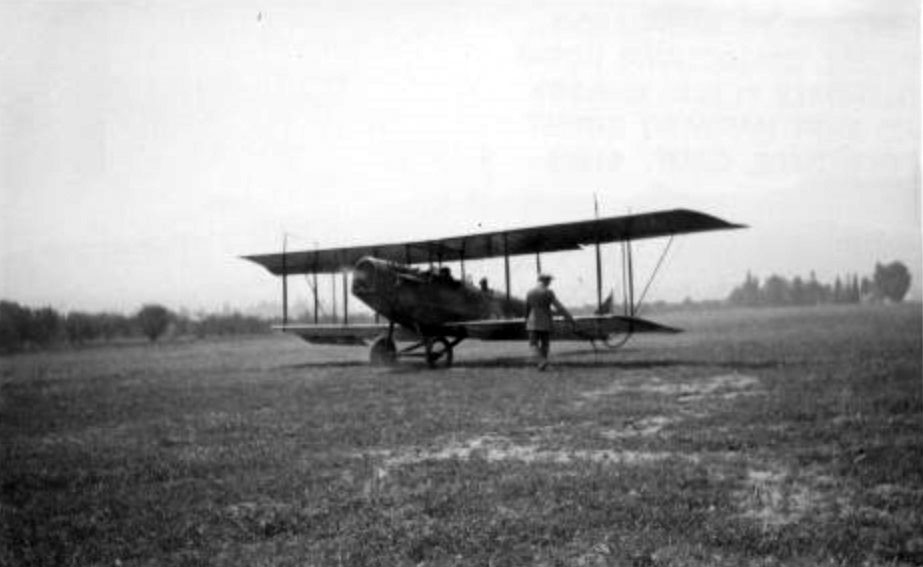 |
|
| (1921)^**^ – View of Leslie C. Brand is his plane preparing to take off at Brand Airfield. |
Historical Notes Brand Field was no longer depicted on a 1931 street map, but “Brand Park” was depicted, so the airfield may have ceased operation by that point.*# |
* * * * * |
Please Support Our CauseWater and Power Associates, Inc. is a non-profit, public service organization dedicated to preserving historical records and photos. Your generosity allows us to continue to disseminate knowledge of the rich and diverse multicultural history of the greater Los Angeles area; to serve as a resource of historical information; and to assist in the preservation of the city's historic records.
|
More Historical Early Views
Newest Additions
Early LA Buildings and City Views
History of Water and Electricity in Los Angeles
* * * * * |
References and Credits
* LA Public Library Image Archive
^ Oviatt Library Digital Archives
** Los Angeles Times Photographic Archive: Municipal Airport
^^ Aerofiles - US Aviation Firsts
*# Abandoned & Little-Known Airfields – Paul Freeman
**#UCLA Library Digital Collections
***Pinterest: 1910 Dominguez Hills Dirigible
**^KCET.org: From Mines Field to LAX: The Early History of L.A. International Airport
*^^California State Military Museum - Mines Field
#^^Los Angeles Conservancy - DeMille Field No. 1
+^#Aviation Pioneers: Blanche Scott
^**Dmairfield.com: Mines Field
^*#Noirish Los Angeles - forum.skyscraperpage.com; Rogers Airfield; Multiplane Crash; Demille Field No. 2
*#*San Diego Air & Space Museum Archive; Burdett Fuller Collection
^#*theautry.org - From the Ground Up: The Infrastructure of Flight in Southern California
^^#LA Times: Arcadia Balloon School and Ross Field
^^*Los Angeles World Airpots: LAX
*#^LA World Airports - History of Van Nuys Airport
##*Los Angeles Magazine: How a Hollywood Director Almost Launched L.A.’s First Commercial Airline
*^*Seaplanes of the Magic Isle
****Pasadena Museum of History
^##*csudh.net: Dominguez Hills Air Meet
^**^California State Library Image Archive
^*^#Facebook.com - Bizarre Los Angeles
^#^#Pinterest: Bygone Los Angeles
^^#^Facebook.com - Great Photos from Los Angeles' Past: Rogers Airfield
*^ Wikipedia: Los Angeles International Airport; 1910 L.A. International Air Meet at Dominguez Hills; Bob Hope Airport; Grand Central Airport; Airship; Zeppelin; Theme Building; William Wrigley, Jr.; Spirit of St. Louis; Leslie Brand; Grand Central Airport; Glenn Curtiss; Thomas Scott Baldwin; ‘Tiny’ Broadwick
< Back
Menu
- Home
- Mission
- Museum
- Major Efforts
- Recent Newsletters
- Historical Op Ed Pieces
- Board Officers and Directors
- Mulholland/McCarthy Service Awards
- Positions on Owens Valley and the City of Los Angeles Issues
- Legislative Positions on
Water Issues
- Legislative Positions on
Energy Issues
- Membership
- Contact Us
- Search Index